Lucerne – Switzerland’s Nicest City?
Since landing in Geneva over two weeks ago, Alison and I have been blown away by the efficiency of the Swiss transportation system and even more so by the absolute liveability and beauty of its cities, towns and villages. It is very difficult to chose a favourite among the major cities of Geneva, Basel and Zurich and even harder between the smaller places like St. Moritz, Zermatt, Interlaken and Wengen. The combination of modern and medieval is definitely a winner. I honestly thought the places we had already visited could not be topped and then along came Lucerne. In this post we’ll take a walking tour of the city. In the next I’ll visit some other places not on the walking tour and between the two I’ll try to explain why Lucerne is one of the nicest cities I’ve ever visited.
We’ve completed the high altitude portion of this Adventures Abroad walking/hiking tour of Switzerland led by one my favourite people, Victor Romagnoli. In the last post we hit the heights at almost 12,000 feet on the Jungfraujoch railway and had staggering views of Jungfrau, Eiger, Monch and the Aletsch Glacier. But all was not snow and ice from up there. Looking north we could see the green alpine meadows and blue lakes of central Switzerland and that’s where we will spend our final days on this once in a lifetime trip. We took the train from Wengen back down to Lauterbrunnen, then on to Interlaken where we caught the train to Lucerne. From Interlaken, the route took us along the north side of Lake Brienz for some of the nicest views of the entire trip with multiple shades of green contrasting with the emerald blue waters of the lake.
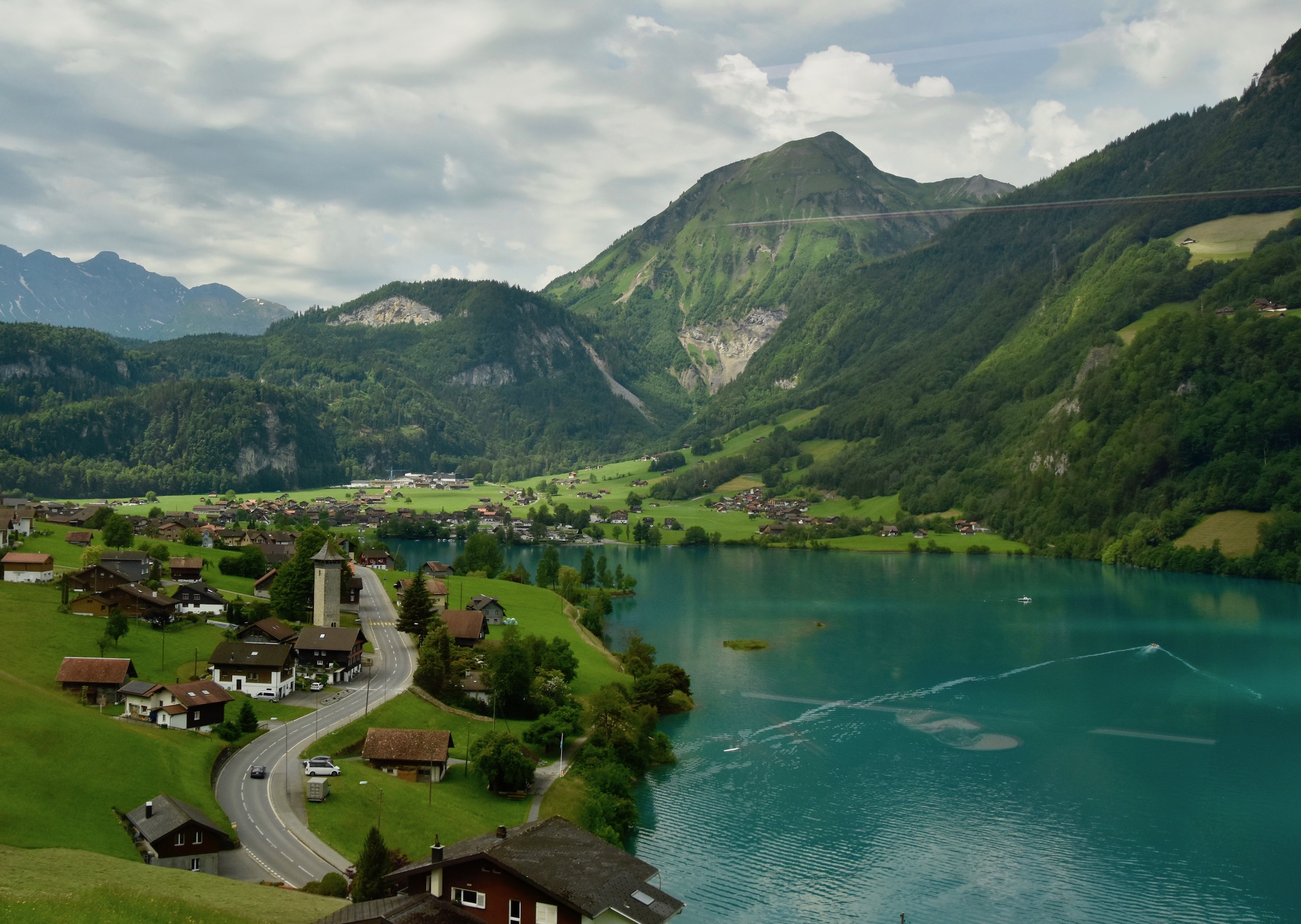
All told it was just under three hours when we pulled into the surprisingly large and busy train station at Lucerne. We had time to leave our bags at the hotel and have lunch before meeting our local guide for a walking tour of Lucerne.
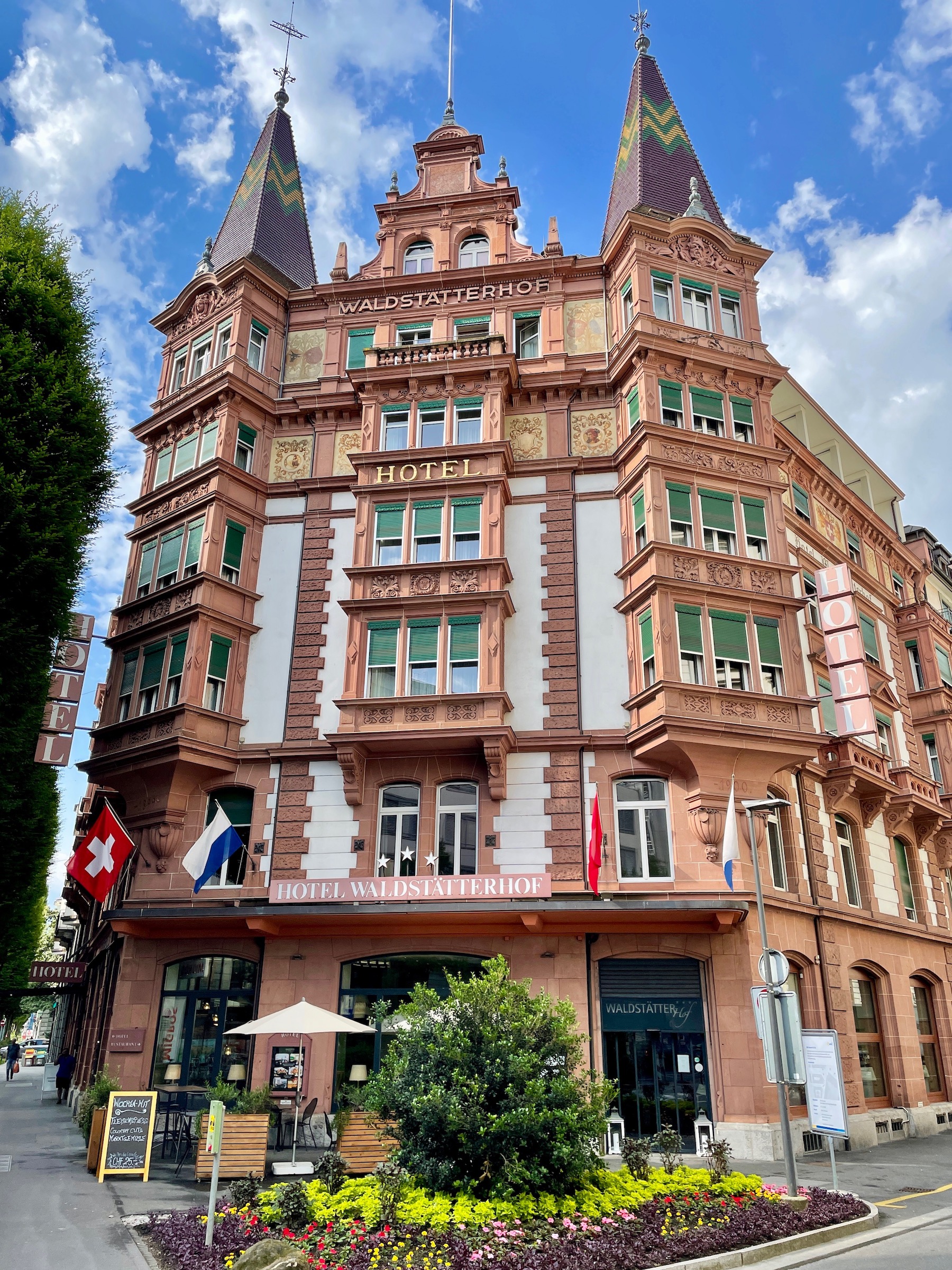
Our hotel for the final three nights of the tour is the quite grand Renaissance Revival style Waldstatterhof which is literally right beside the train station and a minute from the lakefront. In keeping with our previous accommodations it has very nice rooms and a really good restaurant.
History of Lucerne
Lucerne has a location on the Reuss River where flows out of Lake Lucerne on its way to joining the Aare that would seem to make it a natural place for a settlement. However, unlike many other Swiss cities, it does not seem to have been on anyone’s radar until a Benedictine monastery dedicated to St. Leodegar was founded here in 750. Leodegar had been martyred in an internecine religious dispute less than a hundred years earlier in France. He initially had his eyes gouged out and his tongue cut off, but that apparently wasn’t enough for his persecutors and a few years later they finished the job by cutting off his head. And all this in the name of Christianity.
As with any prosperous monastery a sizeable town soon grew up nearby and in 1178 Lucerne was officially declared an independent city by its residents. It was among the very first cantons to join the Swiss Confederacy in 1332. After the group successfully defeated a Hapsburg army at the Battle of Sempach in 1386, Lucerne seems to have largely been left alone by foreign intruders with the exception of a brief occupation by the French under Napoleon. It also bucked much of the Reformation by remaining an essentially Catholic city to this day.
In the 19th century outsiders started to notice what a nice place Lucerne was to visit, with the medieval wooden bridges that crossed the Reuss being a prime attraction as well as sojourns on the lake . These visitors included everyone from Queen Victoria to Mark Twain and a series of grand hotels was built to accommodate them. It was in Lucerne that Cesar Ritz, who was Swiss and not French as most people think, got his first chance to manage a hotel, the Grand Hotel National which became known as the swankest hotel in Europe and before long that descriptive became, ‘the ritziest’. It’s still in business today, but a little out of our price range.
So let’s go meet our local guide Yvonne Bieder who is awaiting our arrival outside the train station.
After introducing herself, Yvonne points out the large stone arch way with a statue on top in front of the station. It is all that remains of the grand 19th century station that was destroyed by fire in 1971. The statue is called Zeitgeist, a word loosely defined as ‘spirit of the times’ and in the case of Lucerne it was the opening of the first Gotthard Tunnel in 1882 that really opened up Lucerne to the outside world. The two smaller figures represent the workmen who gave their lives in digging the tunnel that allowed the dominant figure to raise his arm in triumph. Nowadays it is the most common meeting place in Lucerne as you can hardly miss it from almost anywhere in the city.
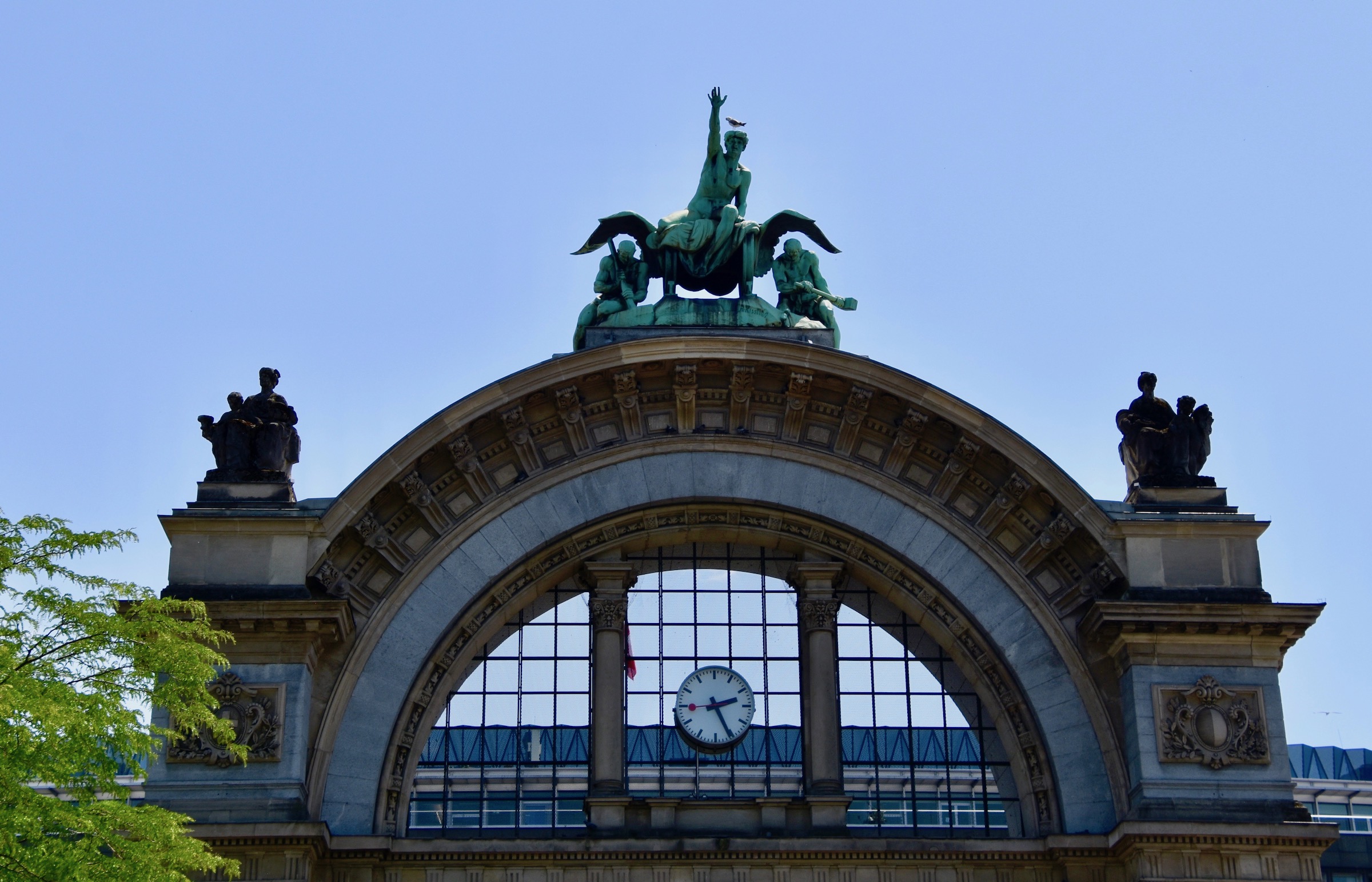
Heading out from the station we cross the street to modern Seebrücke bridge from where we get our first view the iconic Chapel Bridge and the grand hotels that line the Reuss River. Once again you will notice that we are having another fabulous weather day in Switzerland which makes the city walk that much more enjoyable.
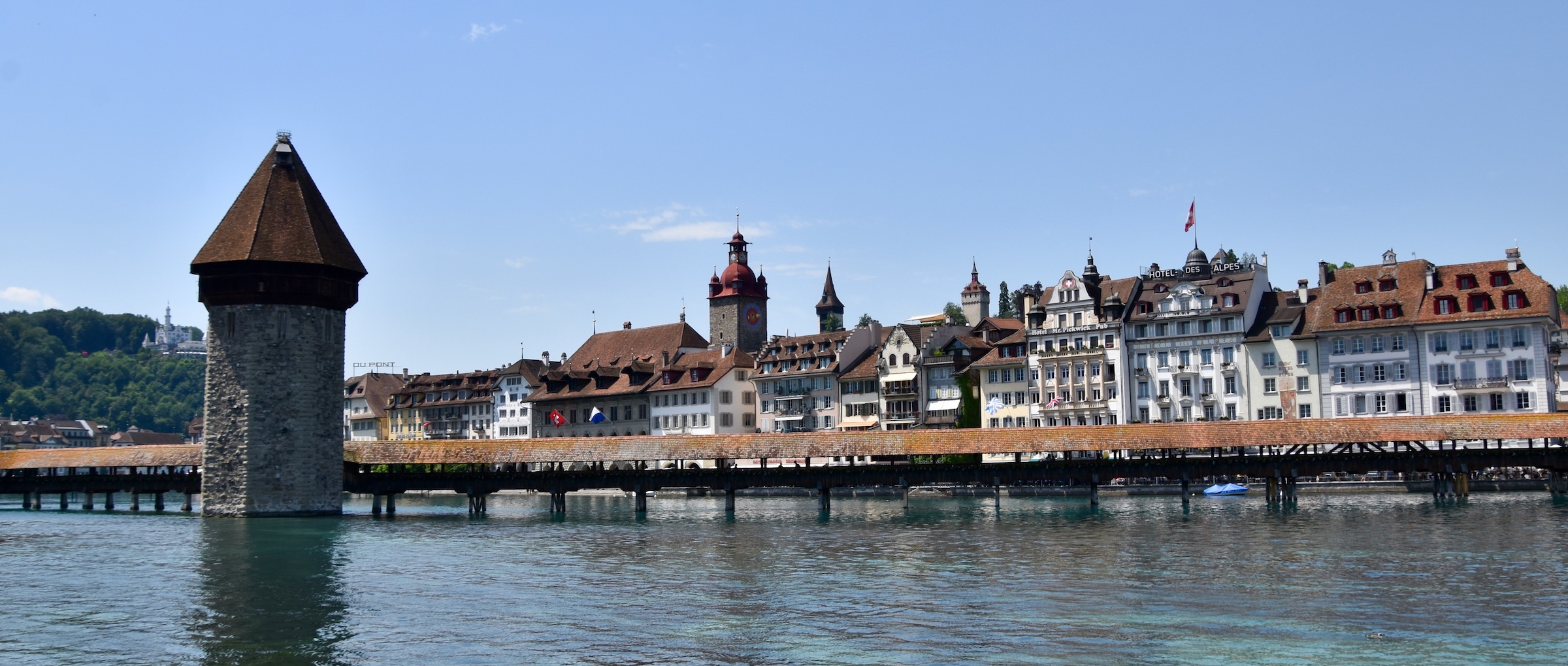
Looking in the opposite direction Yvonne points out the Neo-Classical facade of the Hauptpost building with its four classical sculptures atop Corinthian columns.
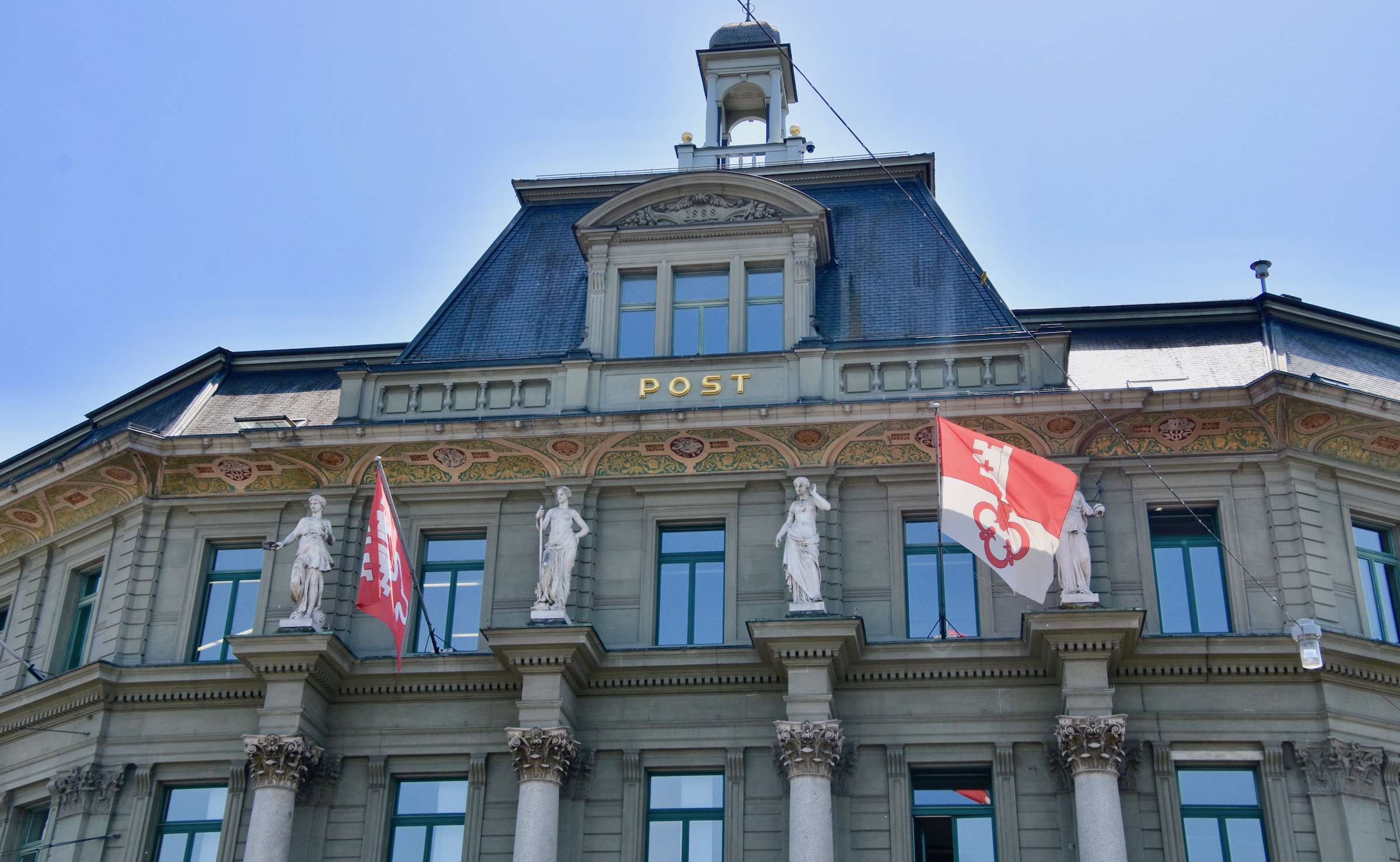
Taking a closer look at the one on the right you can see a tiny figure of Hermes standing on a globe. As messenger of the gods he is frequently used a symbol for post offices around the world who could only wish for his efficiency at delivering the messages they are entrusted with.
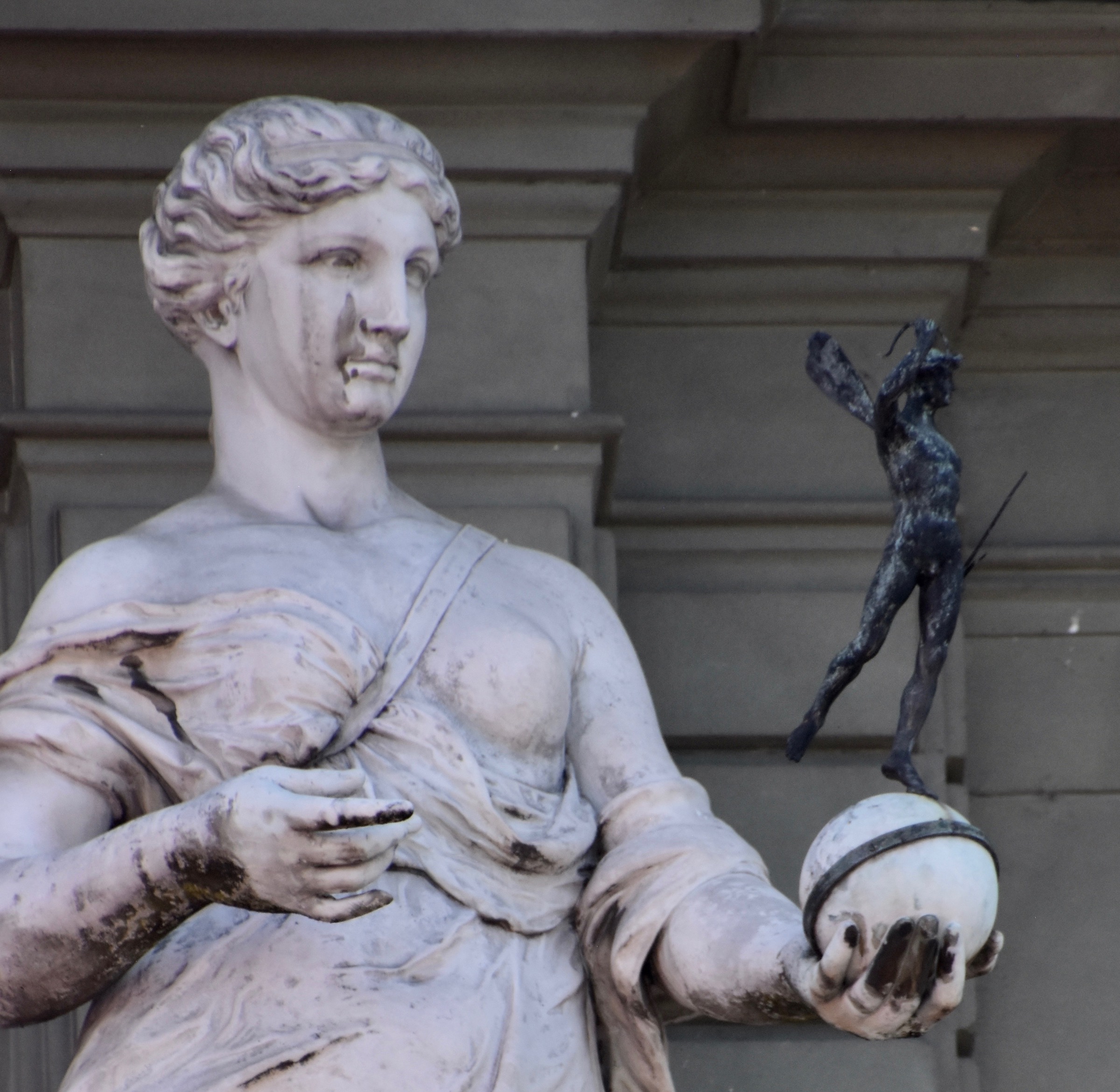
Walking along the Bahnhofstrasse, the street on the north side of the Reuss River we come to entrance to the Chapel Bridge which has dozens of these lovely flower boxes attached to both sides of it.
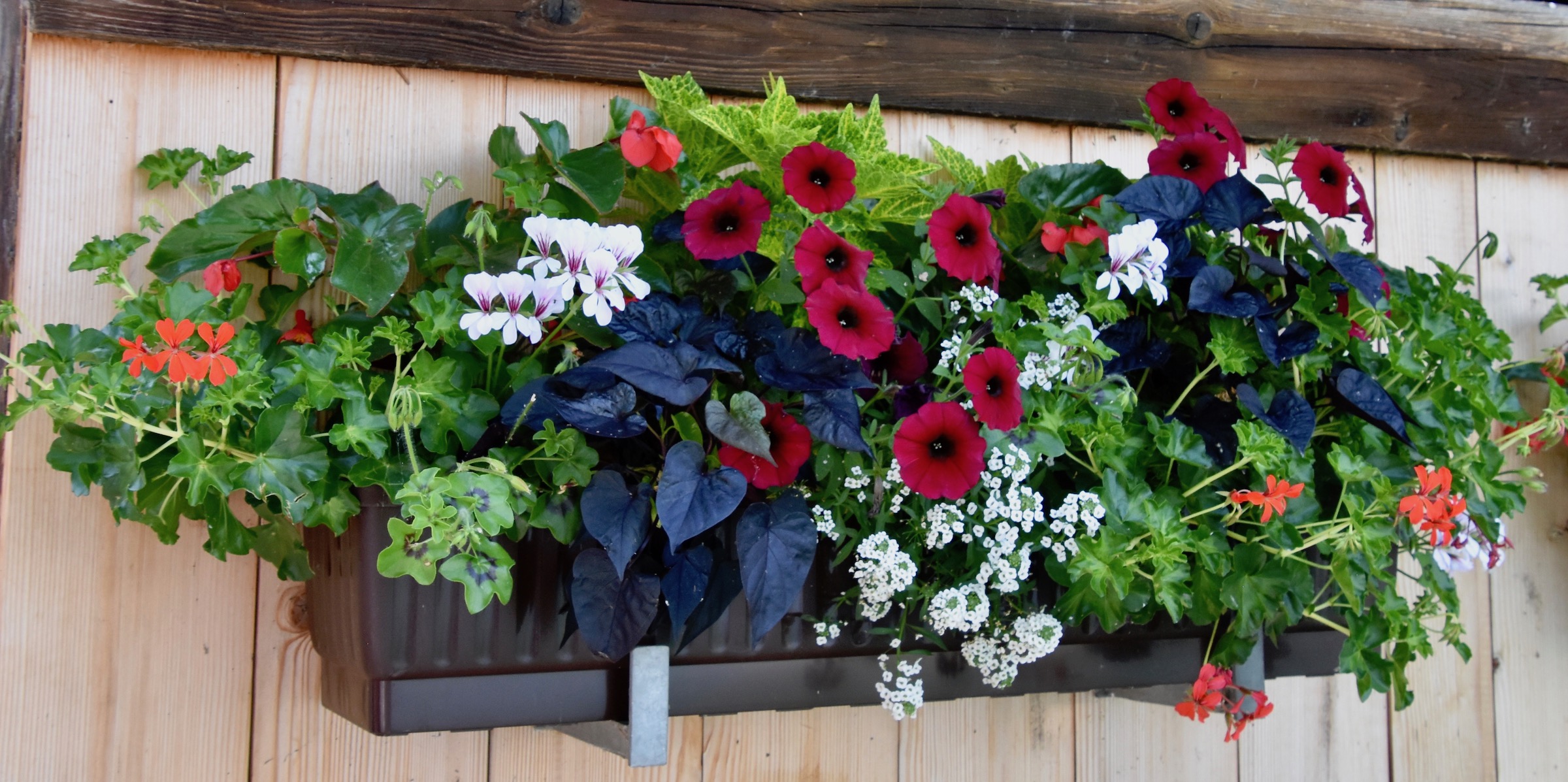
The Chapel Bridge or Kapellbrücke as it is properly called, dates all the way back to 1365 when it was built to connect the old town to the new town that was growing up on the opposite side of the river. It is named after the original St. Peter’s chapel which dated from the 12th century and stood at one end of the bridge. The current St. Peter’s dates from the 18th century and is rather indistinctive. The Kapellbrücke is not only the oldest covered bridge in Europe, but the oldest truss bridge in the world. FYI a truss bridge is one that uses joined triangular pieces called trusses that create additional load bearing capacity. One of other most famous truss bridges is the Quebec bridge that crosses the St. Lawrence River in Canada.
Another feature that makes the Kapellbrücke so photogenic is the Wasserturm or water tower that is connected to the bridge structure. It is actually older than the bridge and once served as a prison.
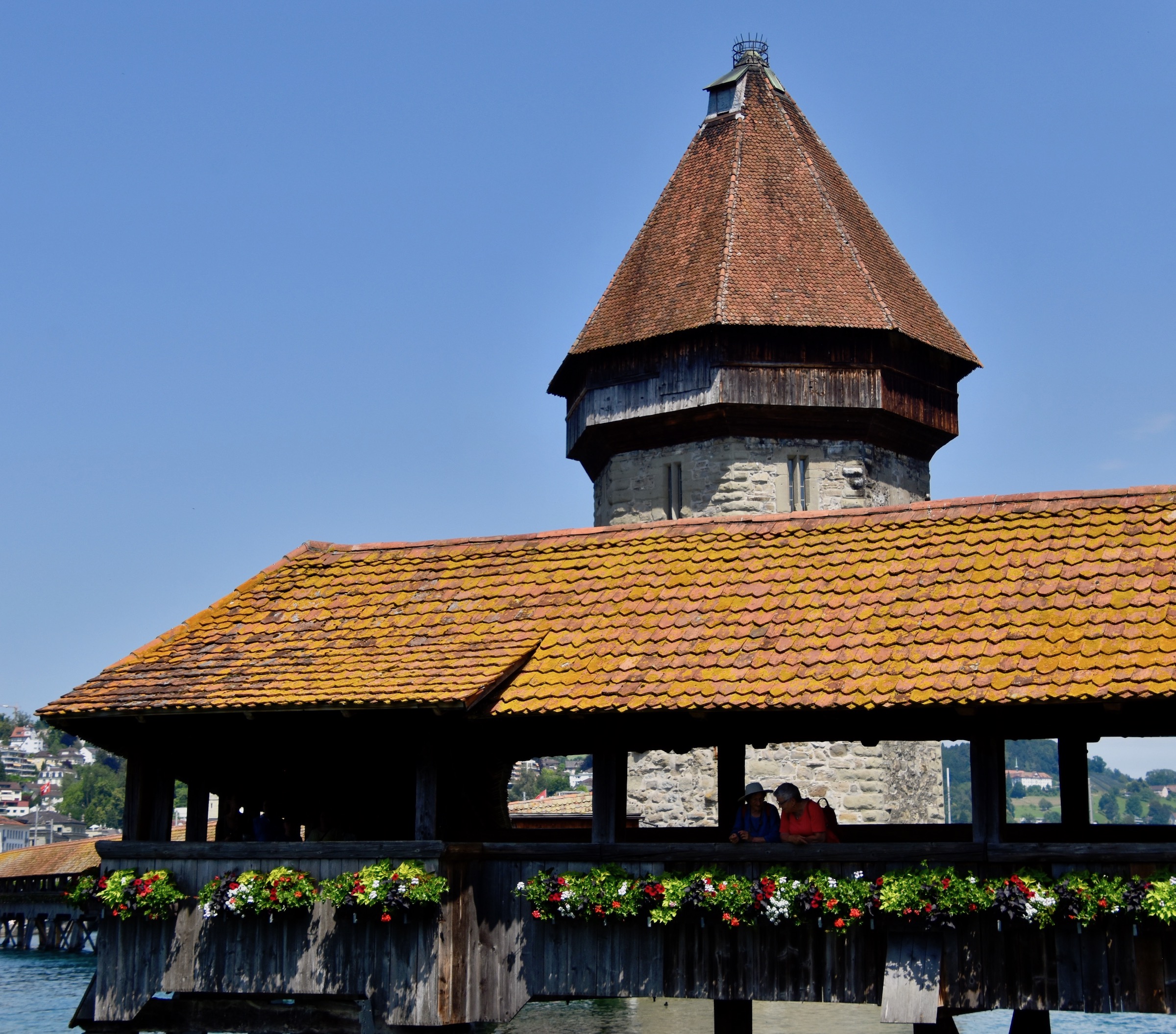
Trust me, you will never get tired of looking at and photographing from all different angles this iconic symbol of Lucerne. However, there is another reason the bridge is so famous, the 17th century triangular paintings that grace the interior. Executed by local artist Hans Heinrich Wägmann, they depict scenes from Lucerne’s history and legends. Originally there were 158 panels with scenes on both sides, reduced to 147 in modern times as the bridge was shortened due to infilling and then after a disastrous fire in 1993 to only 30 that were salvageable. Even so, the 30 that remain will grab your attention. You could literally spend the afternoon looking at the intricate details in each painting. Luckily for the viewer, each panel has an explanation of what the scene depicts and Yvonne points out some of the more interesting ones.
Originally I was going to just put them in a gallery, but I think they are so interesting that they deserve a fuller explanation.
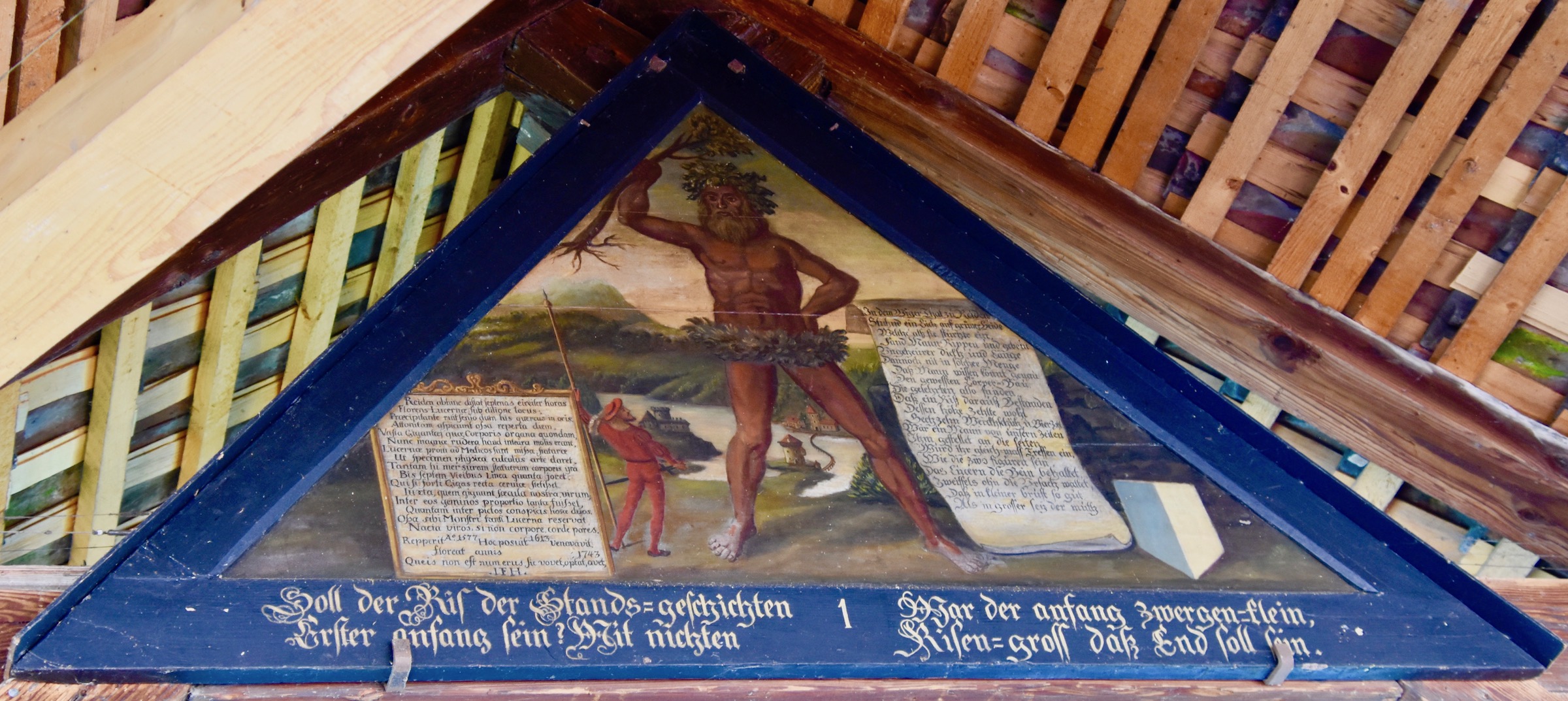
In 1577 the bones of a supposed giant were found near the town of Reiden and he is depicted in the first panel you see. Note the bridge between his legs which depicts a causeway to the Wasserturm and not a bridge.
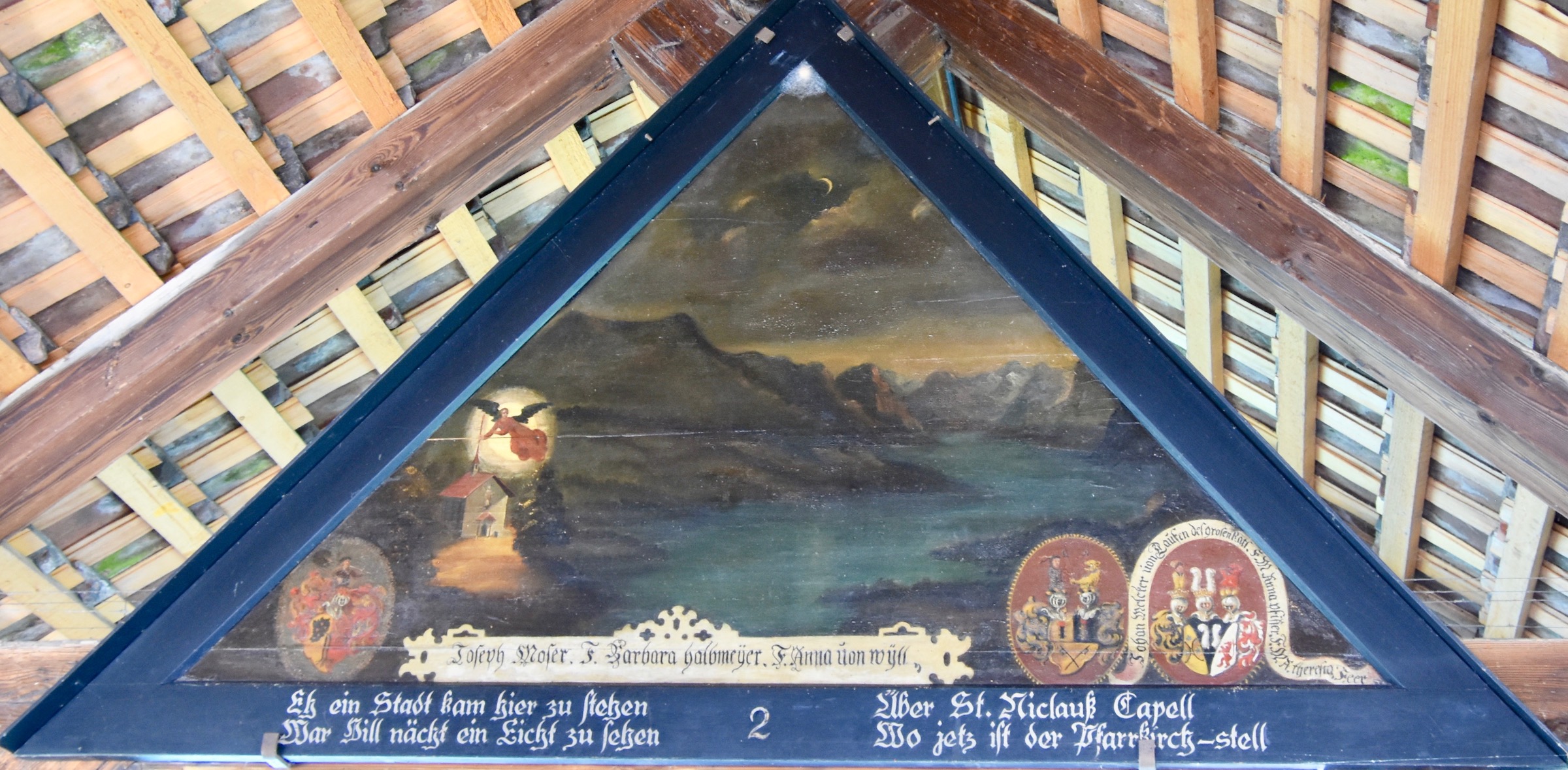
This depicts the founding of Lucerne by an angel pointing to where a chapel should be built on the banks of the Reuss River. Note that each painting was sponsored by one or more local families who had their crests or coat-of-arms included in the scene.
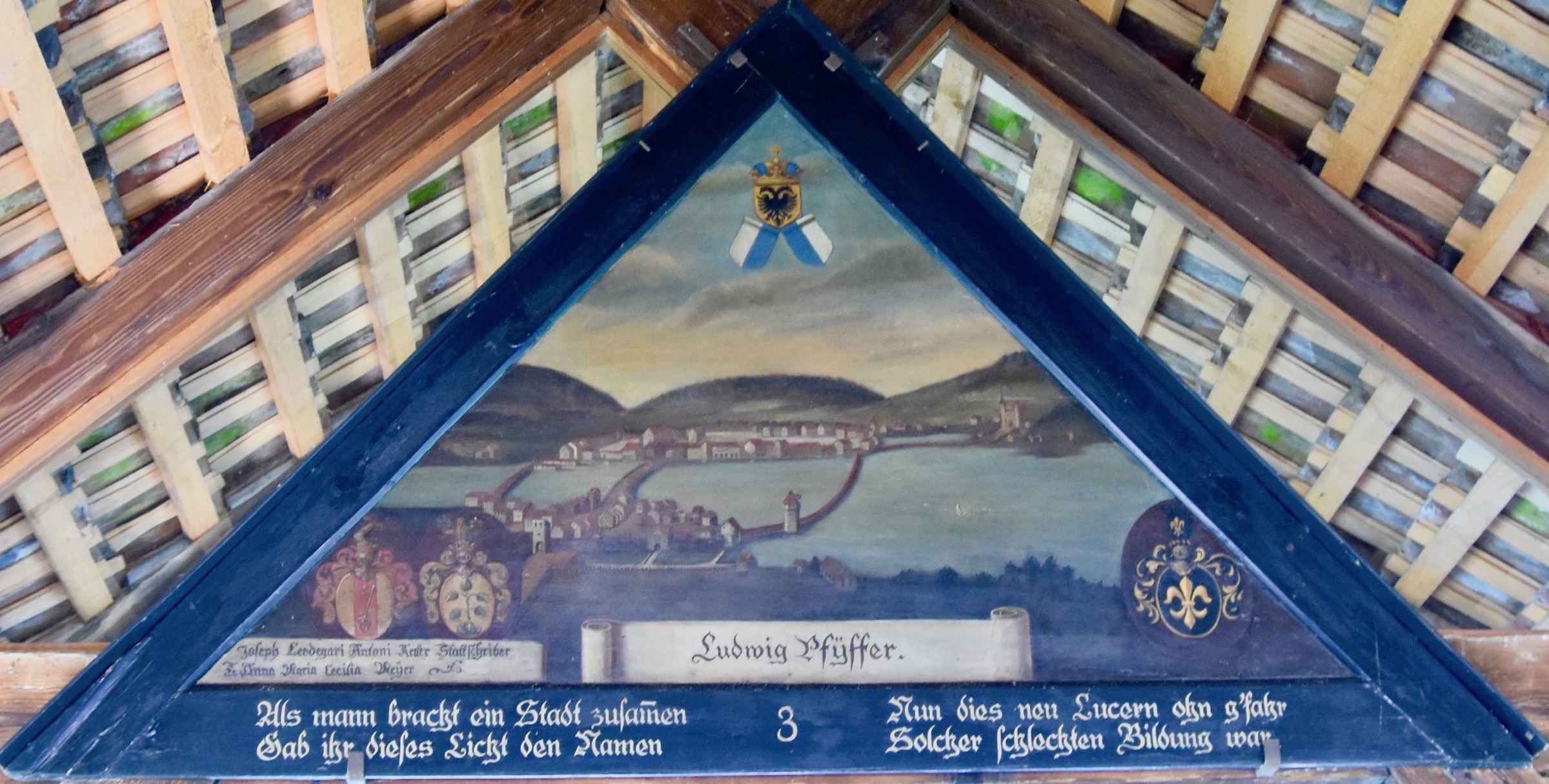
This scene depicts Lucerne in the late medieval period when there were actually three bridges crossing the Reuss.
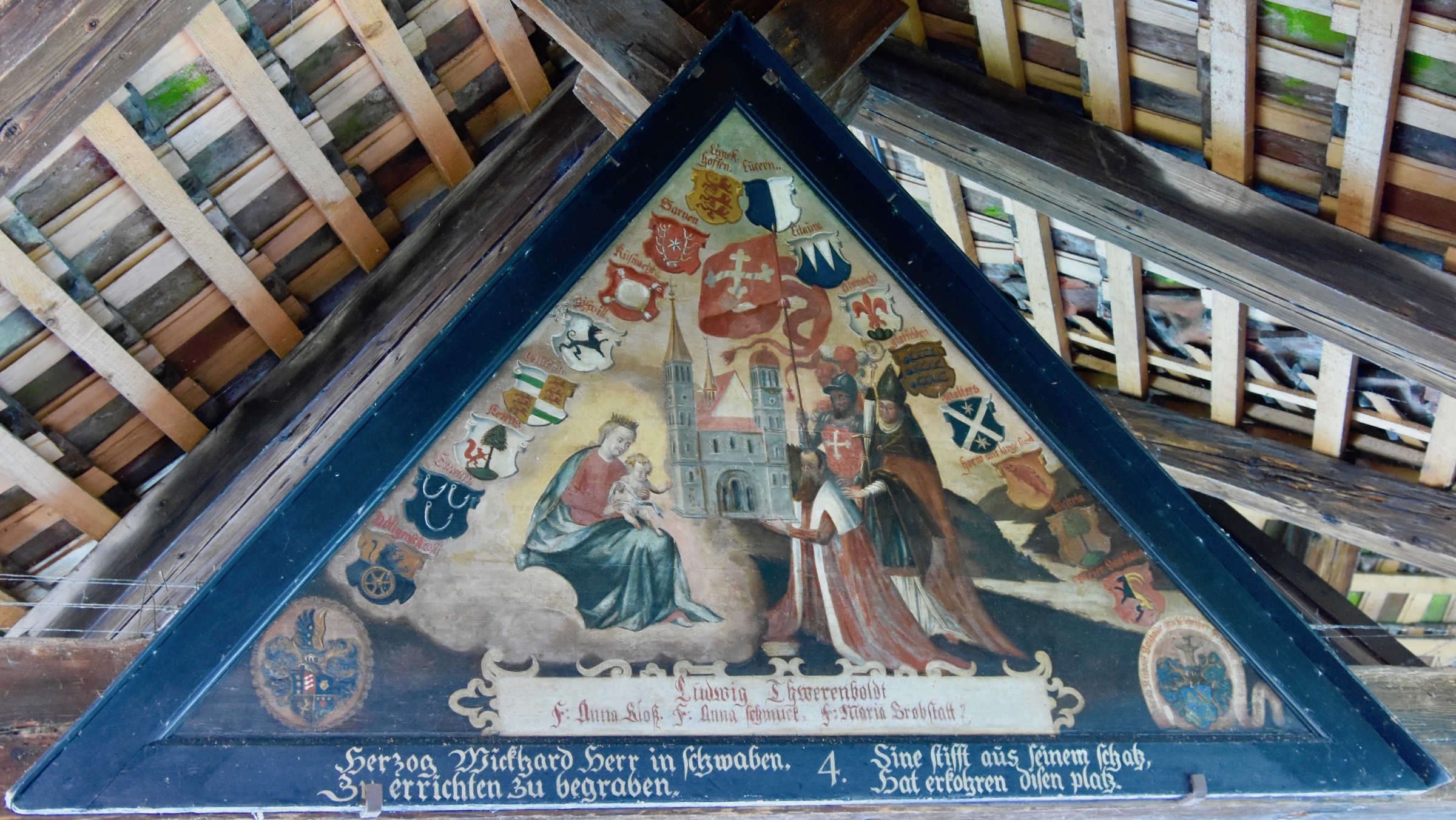
In this painting a priest named Wichardus presents the Virgin Mary & Jesus with a model of the church that is to be built at the site of the old monastery. Wichardus is flanked by St. Leodegar and St. Maurice who we first encountered in St. Moritz.
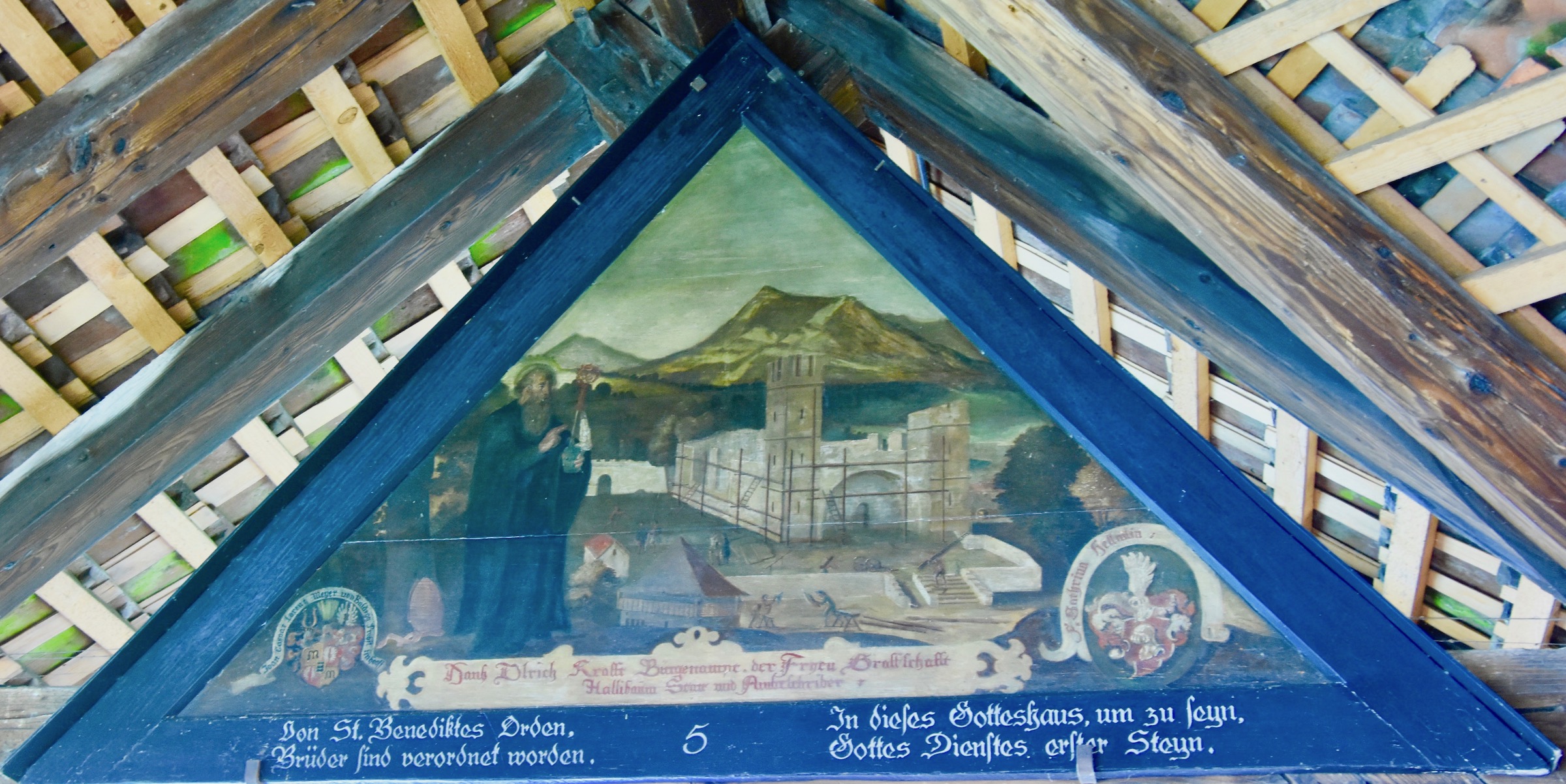
Next we see the Kloster under construction with St. Benedict acting as project manager.
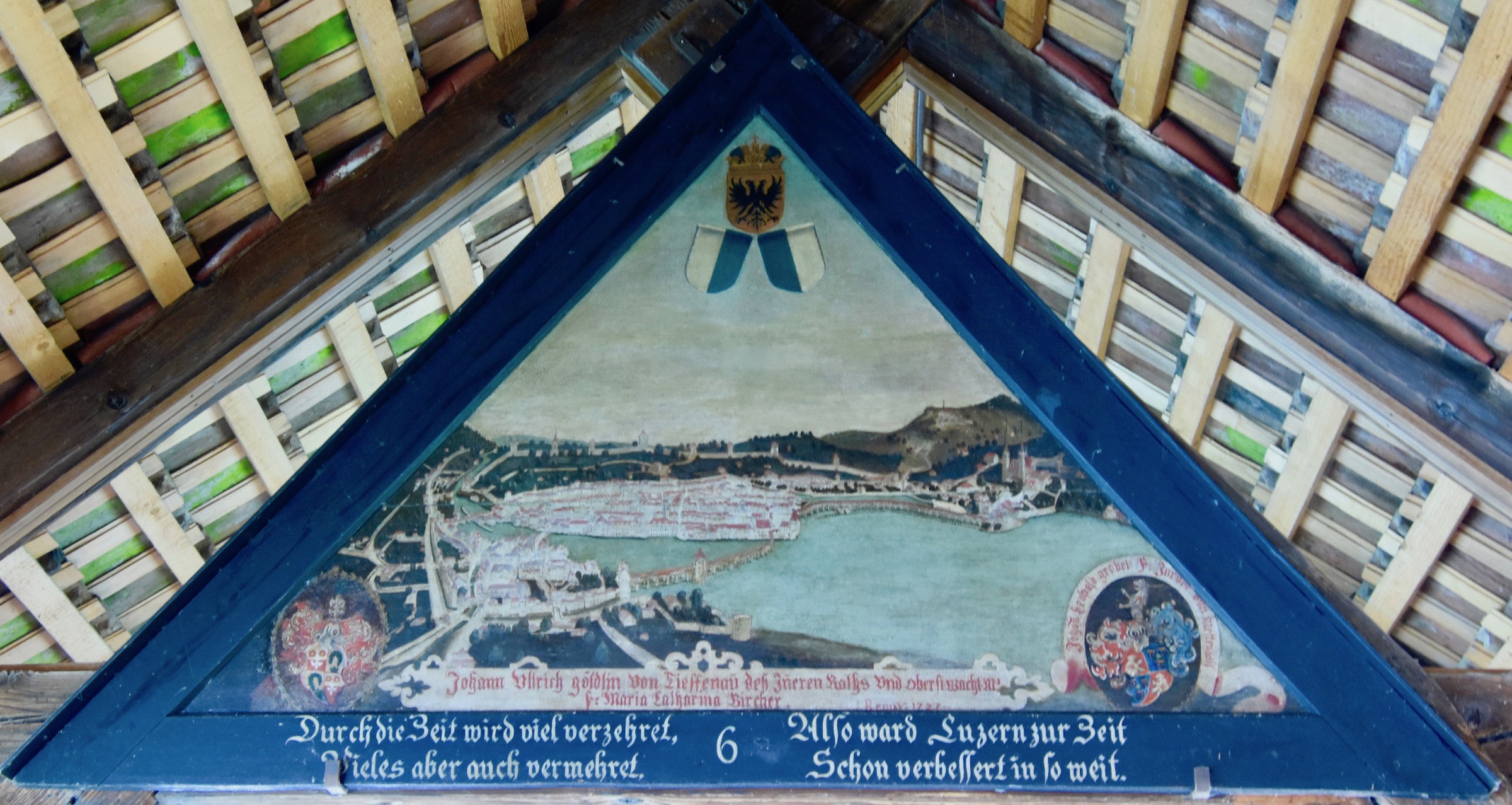
Panel 6 fast forwards to what was then present day Lucerne with this scene depicting the city as it looked in 1615.
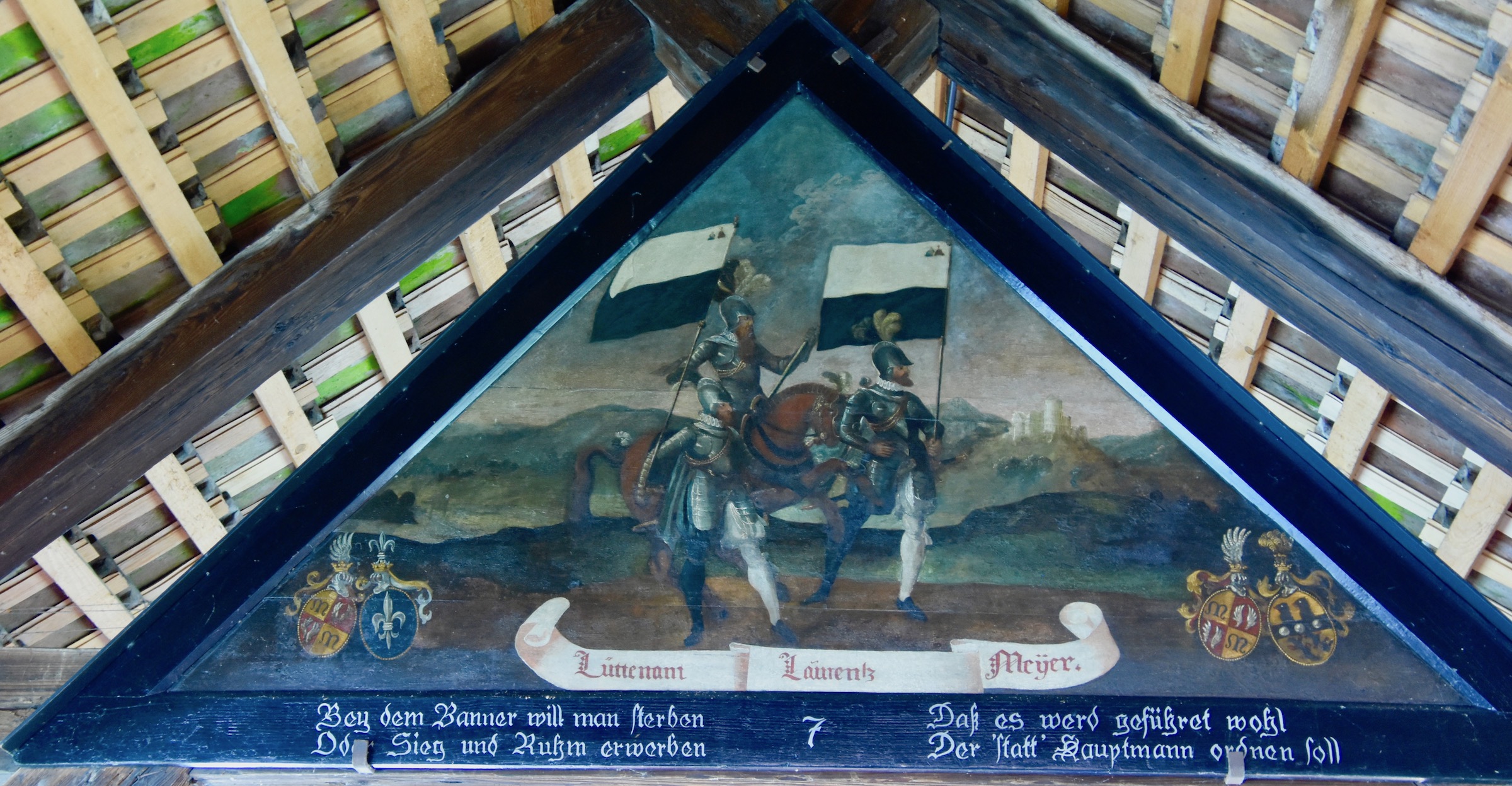
In panel 7 the scene switches from the bird’s eye view to a close up of the Lucerne military commander and his two ensigns staring at who knows what.
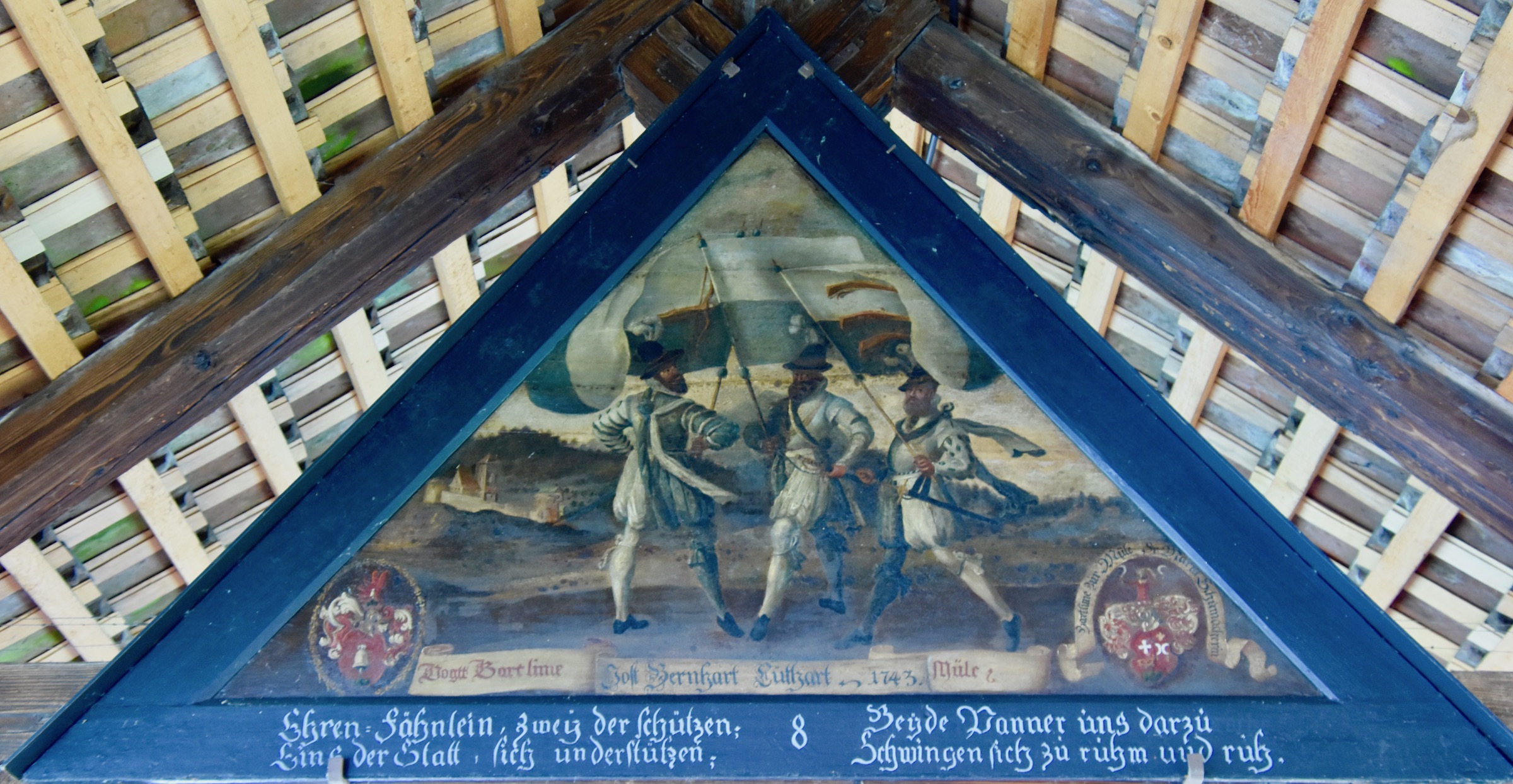
And here’s the same three guys prancing gayly in garb worn to participate in the Schützenfest, an annual event of marksmanship dating back to 1424.
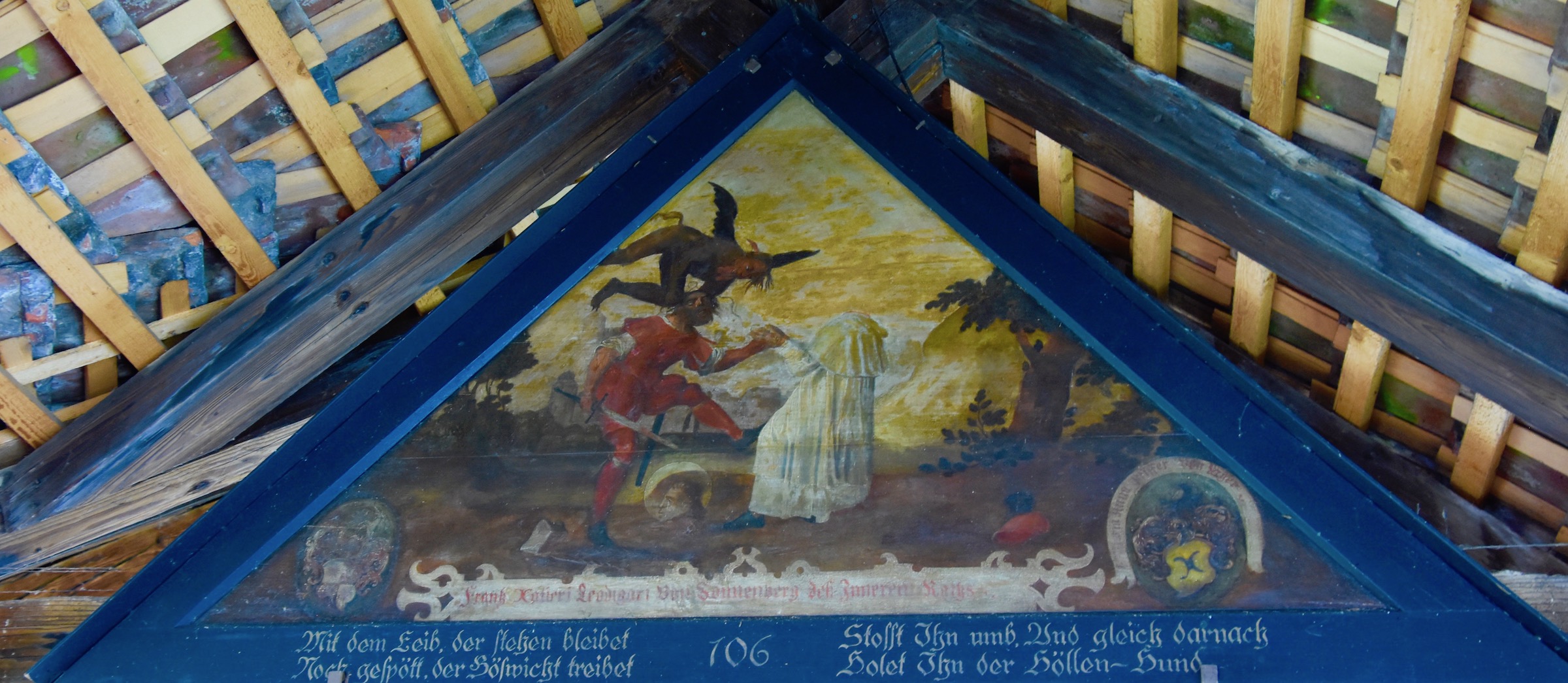
This is a panel on the opposite side of the ones depicting the history of Lucerne. The panels on this side depict the life of St. Leger aka Leodegar and St. Maurice. Remember I wrote that Leodegar was beheaded. This is the scene that depicts that act with the saint’s head glowing on the ground while the body remains standing. A devil appears and drags the executioner straight to hell as payment for his wicked deed.
Yvonne and Victor had to almost literally drag me and a number of others away from our entrancement by these panels which except for the ones on the Chaff bridge which we will visit later in this post, are unique. But we had to soldier on.
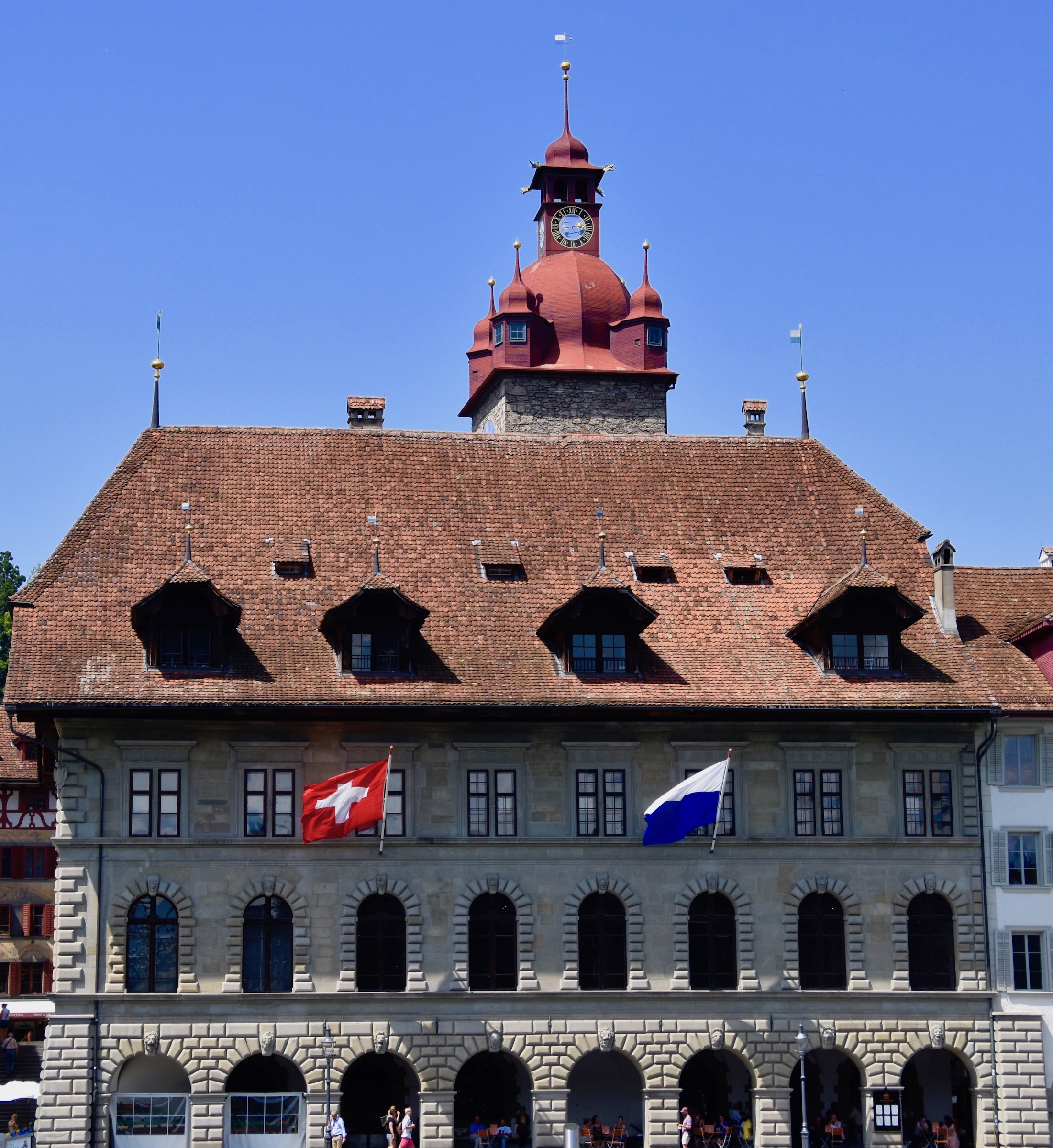
This is the Lucerne Rathaus or town hall which dates to 1606 and combines a Renaissance main body with a definitely Swiss roof. It’s actually a pleasing combination.
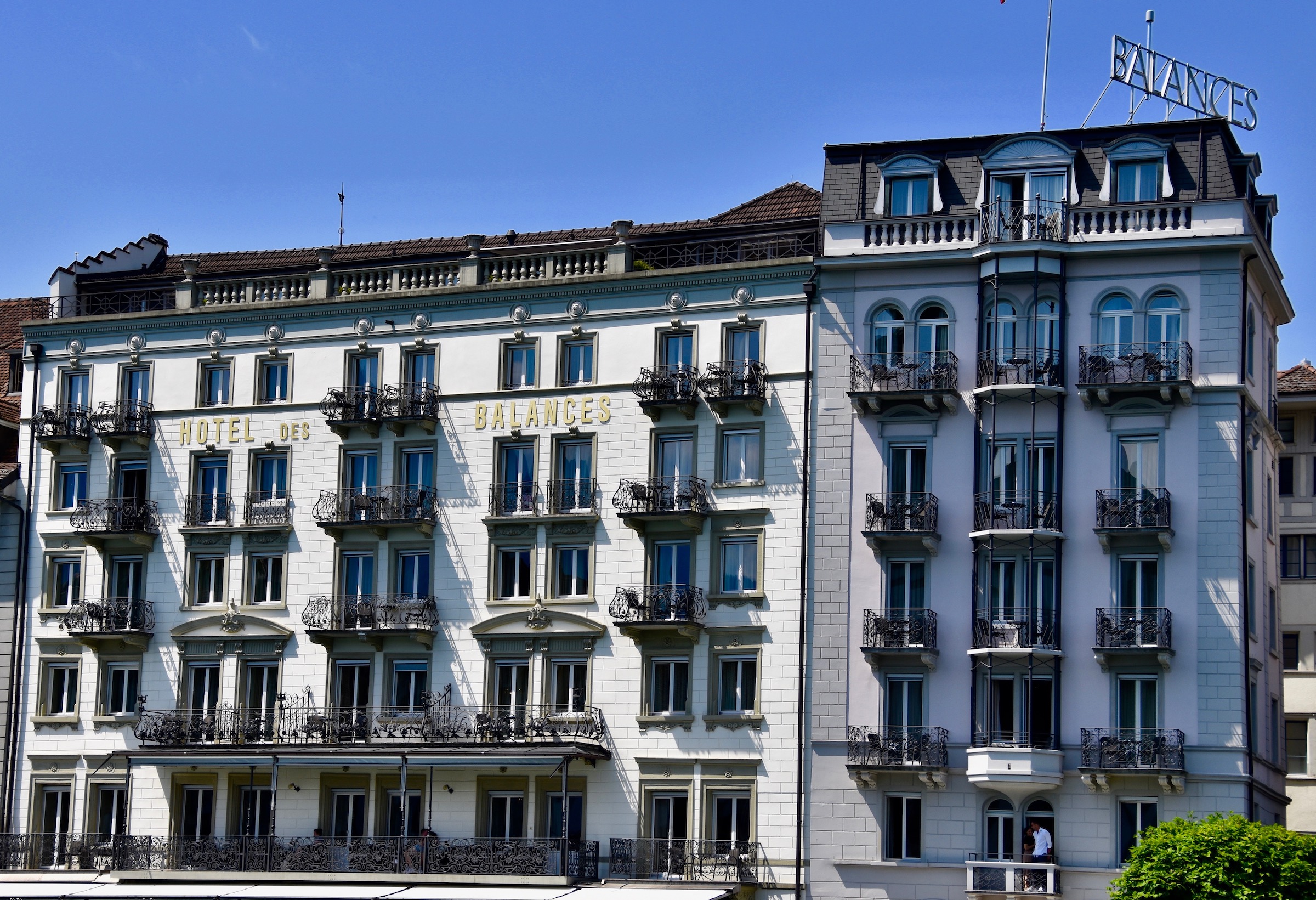
This is the Hotel des Balances with its Venetian style facade overlooking the Reuss River. There has been an inn on the spot since the 12th century and the current iteration opened way back in 1836. Yvonne told us to note this side of the hotel and contrast it to the other side which we will see after we cross the river.
This is the over the top Chateau Gütsch which sits on a hill overlooking Lucerne and is a visible testament to having more money than good sense which is perhaps why it is currently owned by a Russian oligarch. Michael Jackson was another potential owner, but apparently backed out at the last minute.
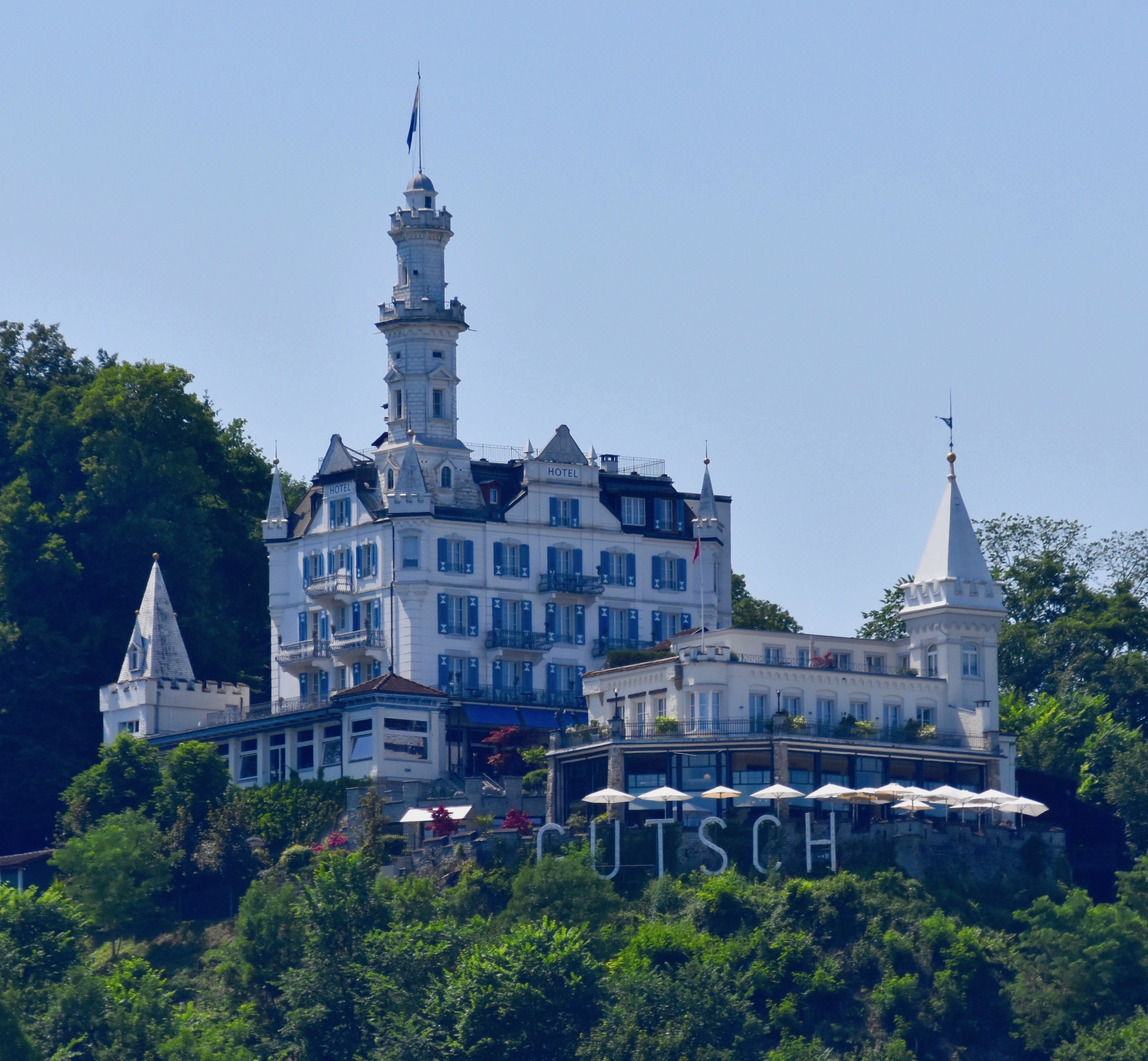
We had now reached the major church in Lucerne, the Catholic St. Francis Xavier. The Jesuits were one of the main forces in the Counter-Reformation and the burgers of Lucerne wishing to forego the stringency of the teachings of Calvin and Zwingli that had caught hold in much of the country, called in the heavy artillery in the mid-1600’s. The result was the construction of the first baroque church in Switzerland
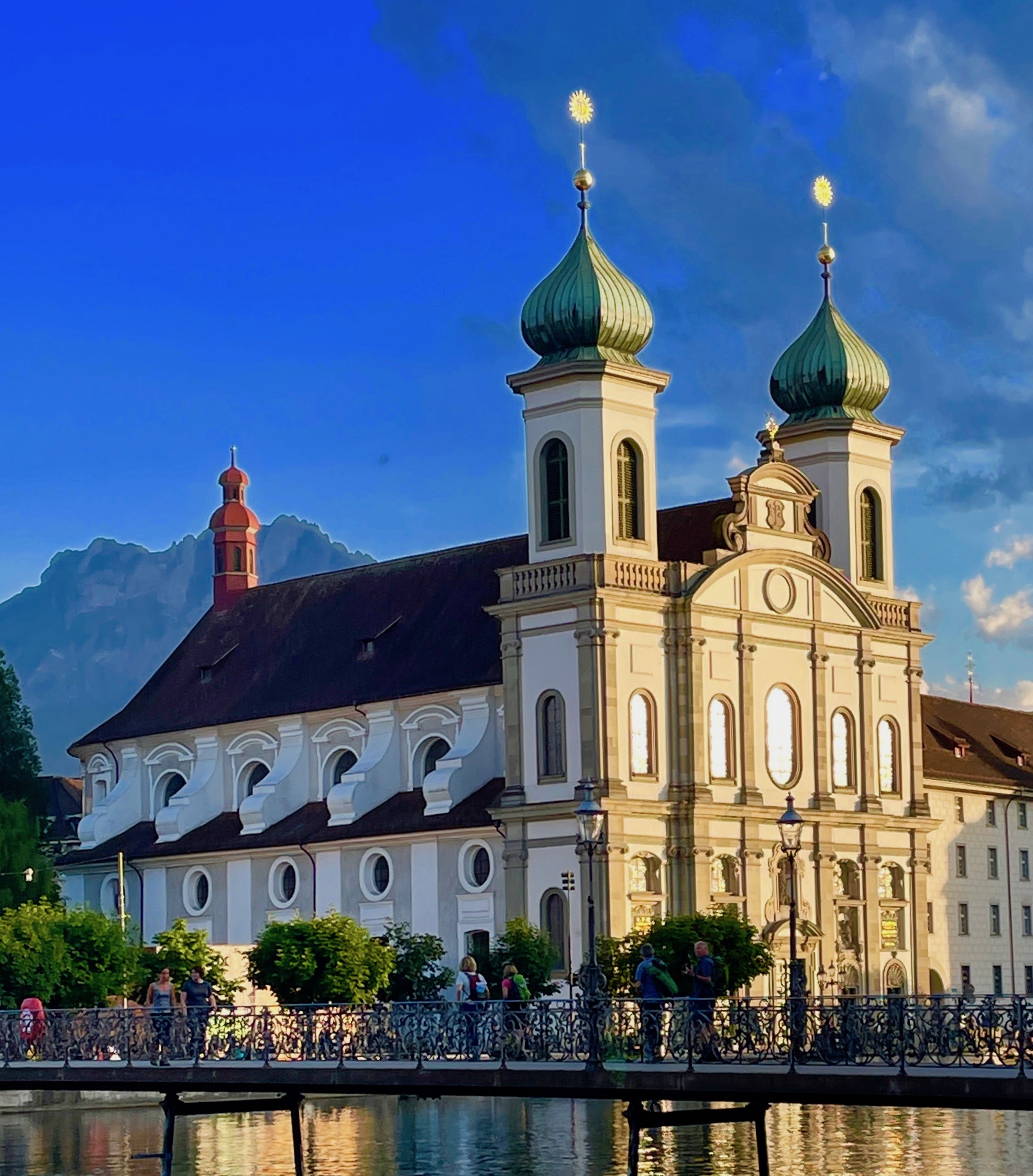
Not so grand on the outside, it is pretty in pink on the inside. Contrast this to the austere interiors we saw in Geneva and Zurich and you’ll get an inkling of the conflict of ideas that shaped the Reformation and its counter movement.
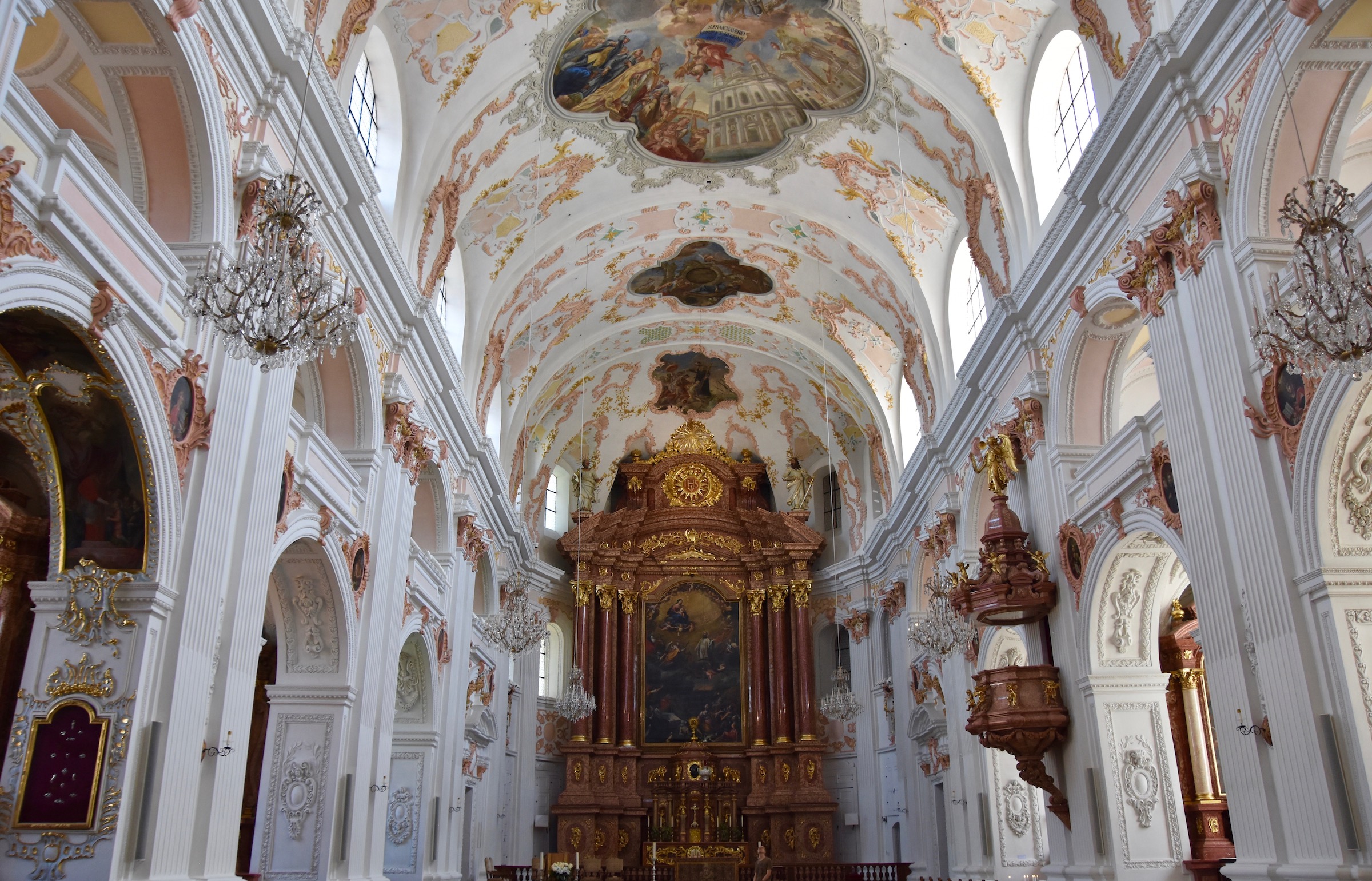
Back outside we reached the famous Lucerne weir with its removable paddles that was built on 1861 to control the water level of Lake Lucerne. The more paddles put in place the more constricted the flow out of the lake and vice versa. It works as well today as it did 150 years ago and is considered another example of Swiss ingenuity. You also get a good view from here of the Lucerne city walls and one of its towers.
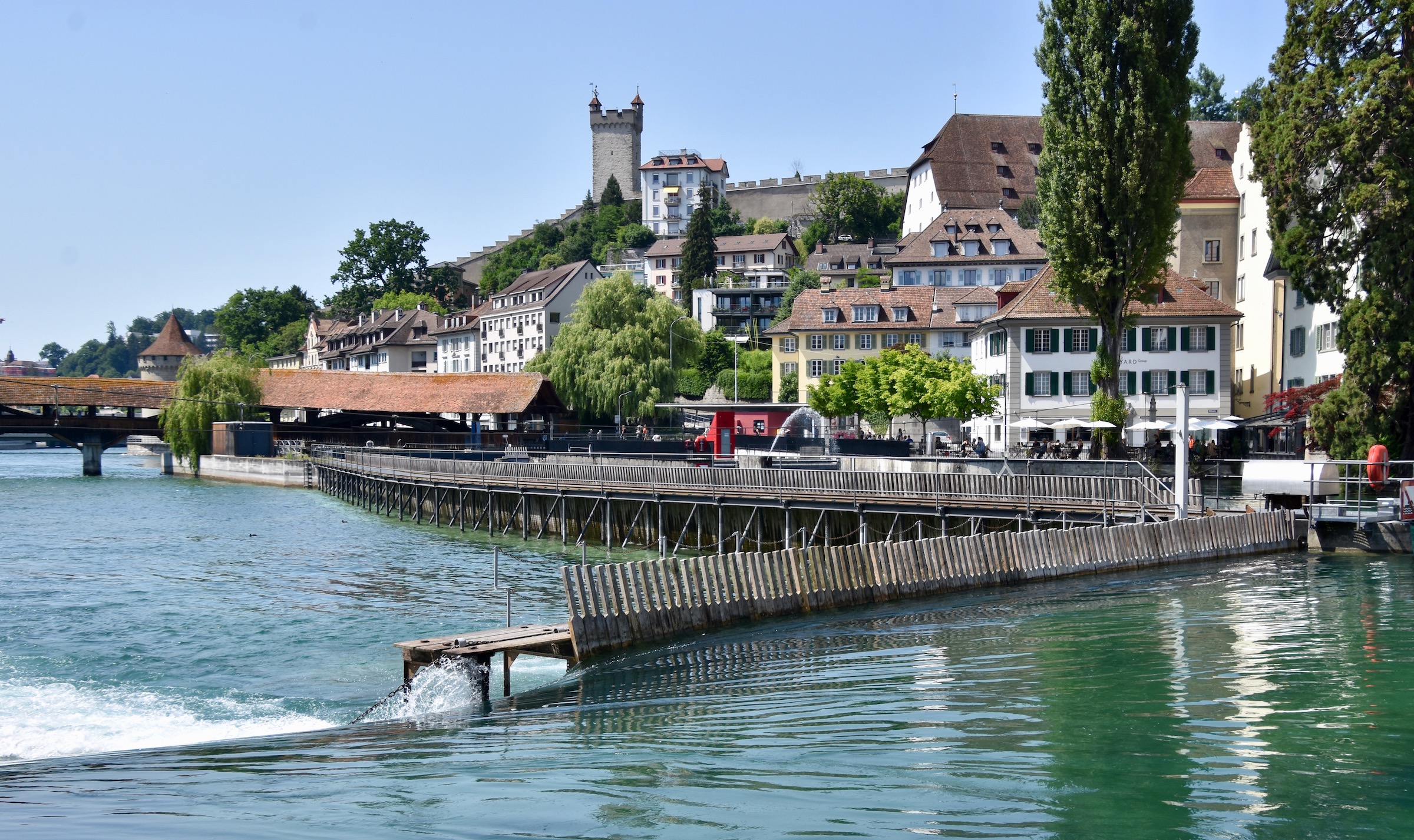
This is the view looking back toward the lake.
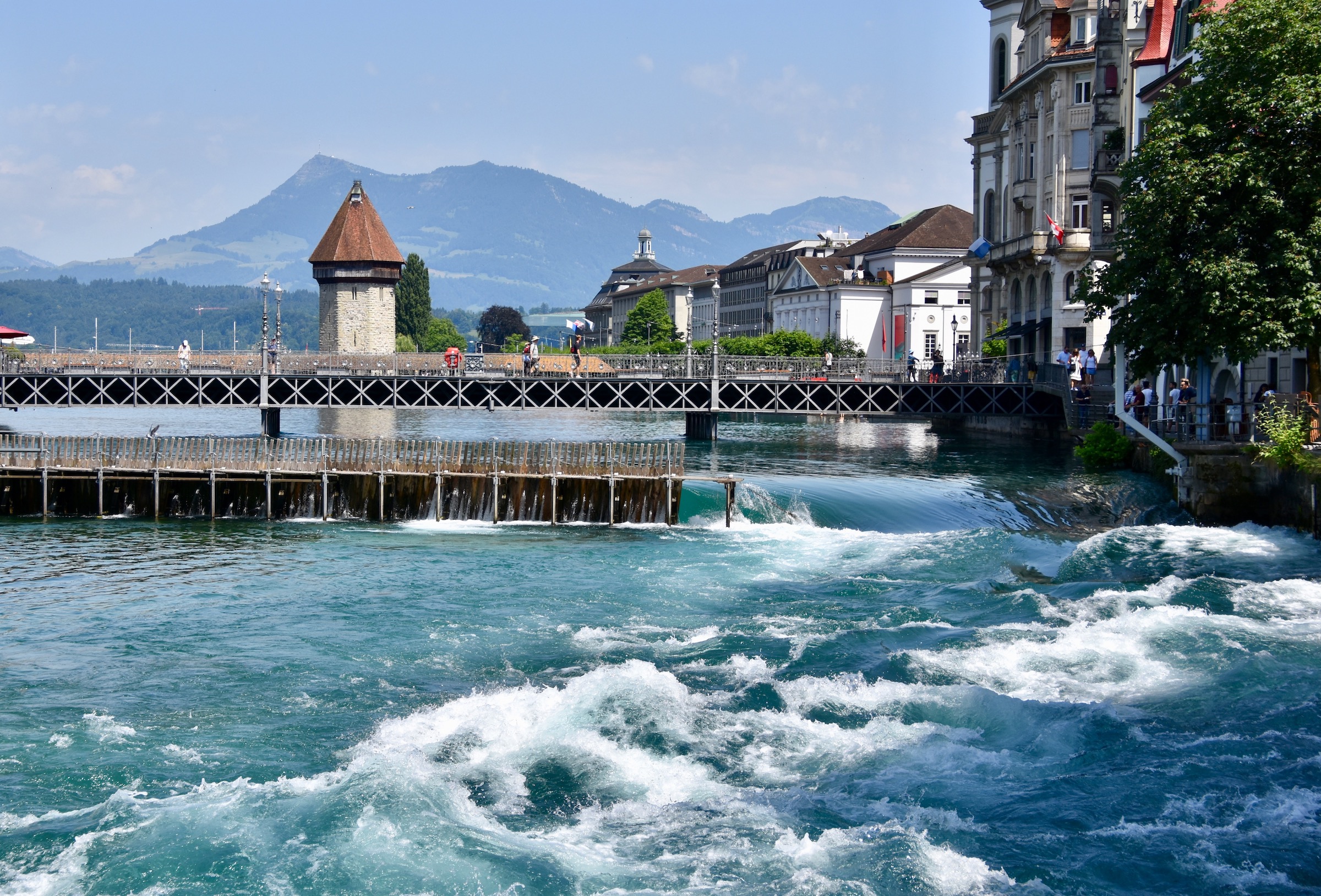
We were now at the entrance to Lucerne’s other famous covered bridge, the Chaff Bridge which dates from 1408. The name derives from the chaff that flew in the air from the many mills located on this area of the Reuss. The small red obtrusion is actually a chapel.
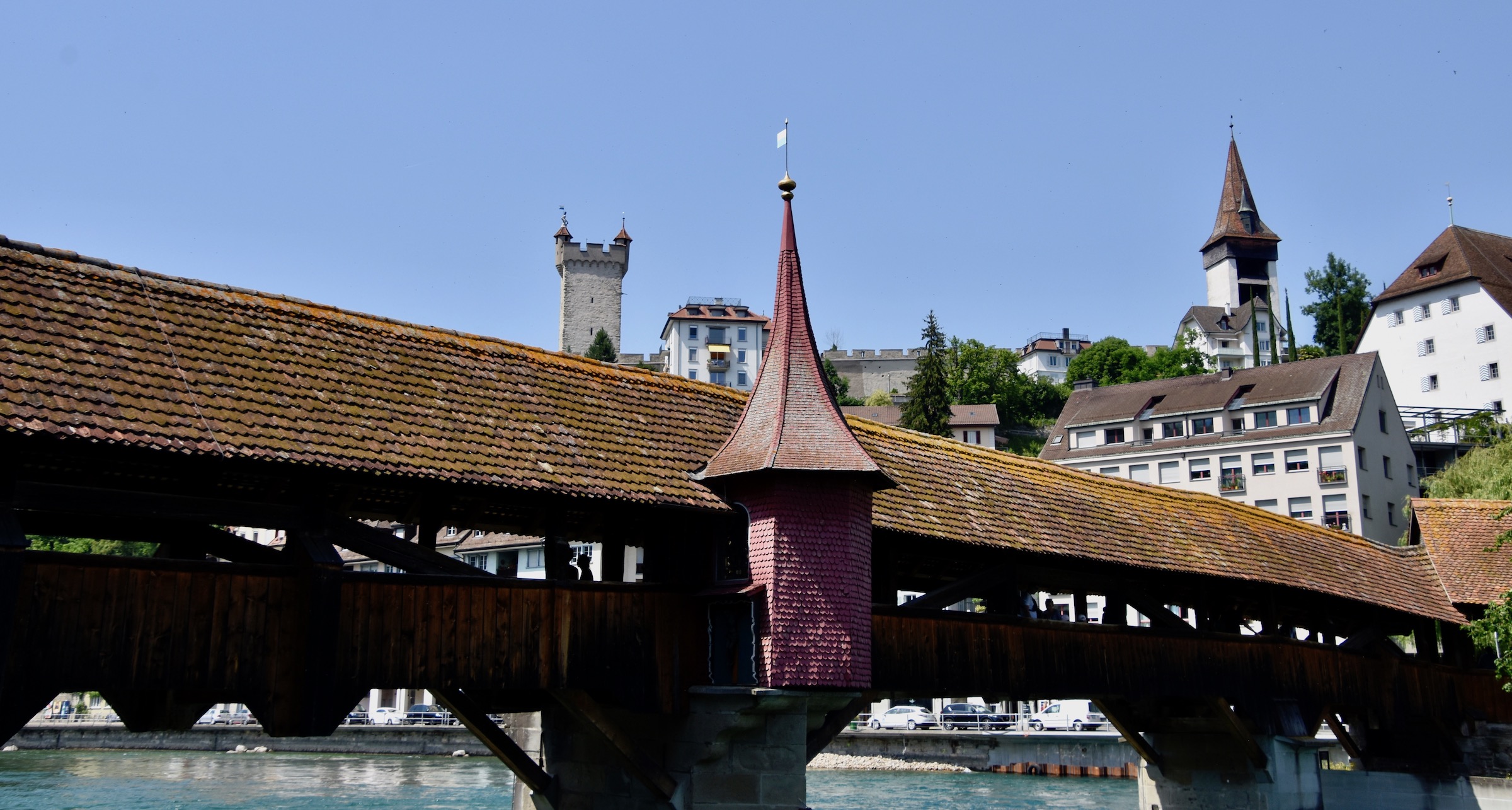
It too has a famous series of paintings, the Totentanz or Dance of Death which are as macabre as anything by Bosch or Breughel. 45 of the original 67 paintings made between 1616 and 1637 are still extant. I found these even more intriguing than the ones inside the Kapellbrücke. Let’s examine a few of them.
The scenes all depict the futility of trying to avoid death, whether high borne or lowly peasant.
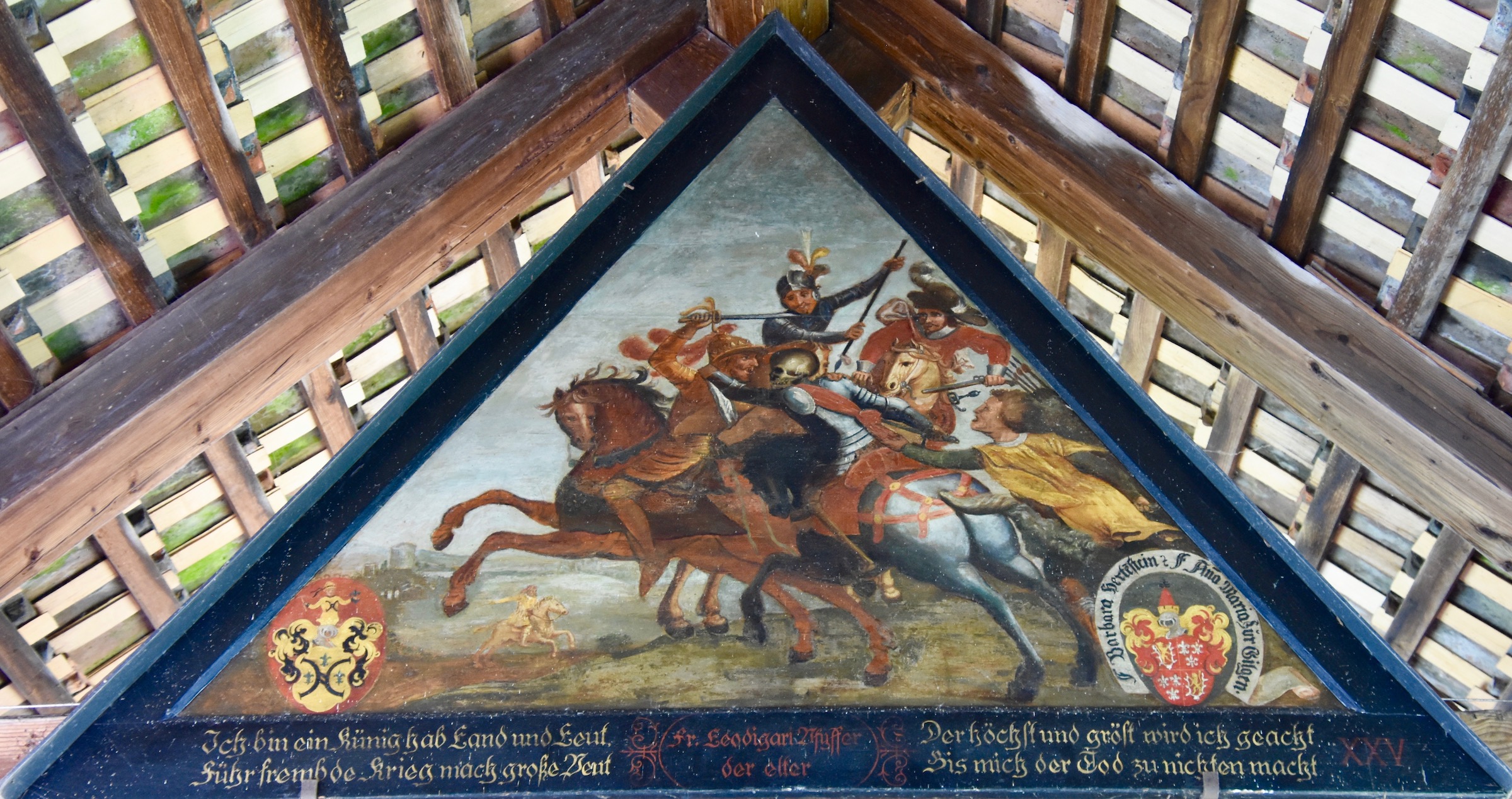
In this panel, a well armoured king in the midst of his body guard cannot avoid death who comes charging in on a pale horse.
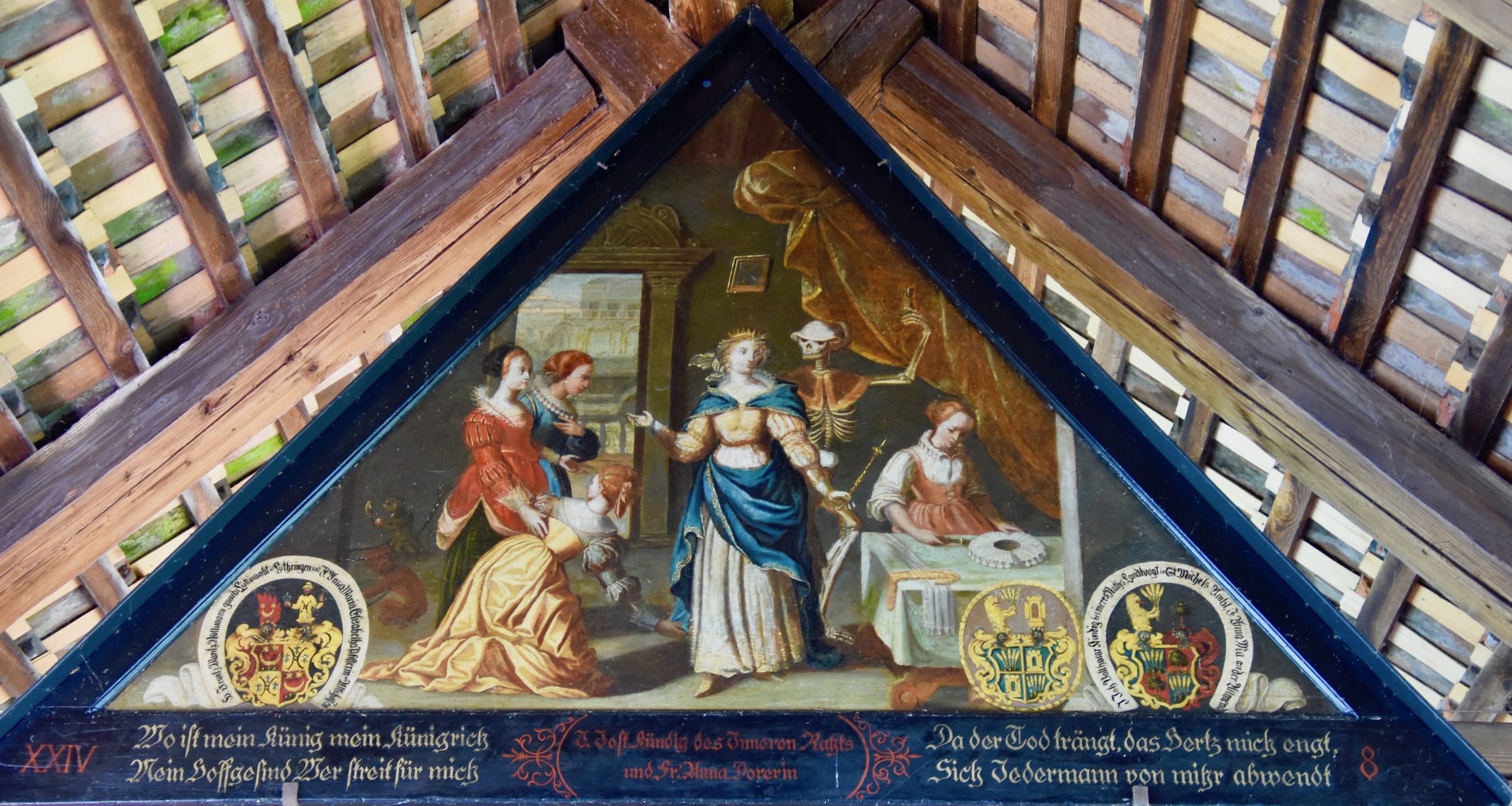
Likewise the queen surrounded by her chambermaids seems immune from harm, when death steps out from behind a curtain, holds up an hourglass and lays a hand on her shoulder.
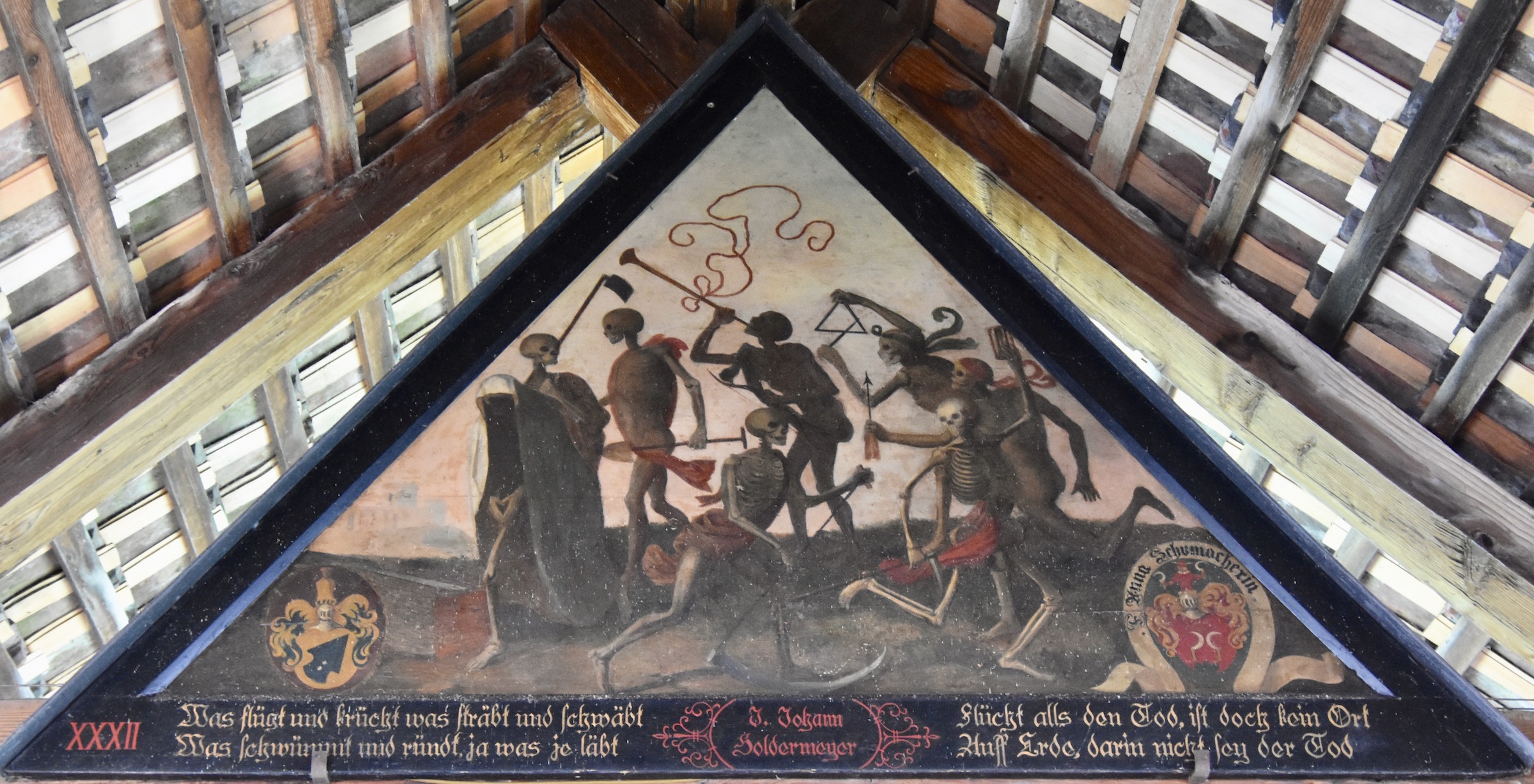
And here literally, the Dance of Death with the skeletons in a circle carrying their instruments of death and burial, from the scythe to the spade. I can’t imagine how creepy this would have been for someone crossing the bridge at night with only a lantern for light creating shadows that would make the figures appear to come alive.
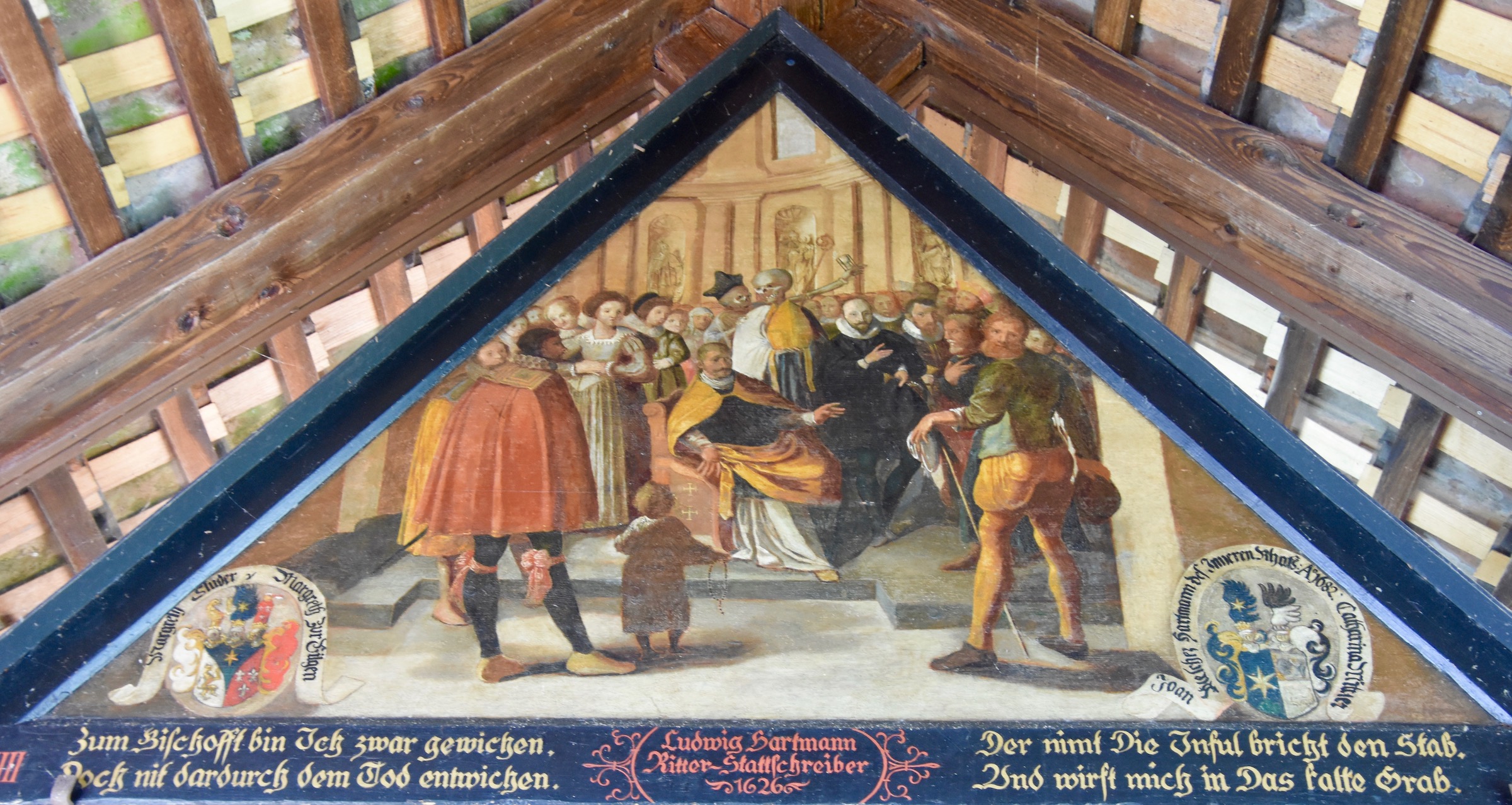
Here is a reminder that even the most pious and God-fearing are not going to avoid the fate that awaits everyone. A bishop is adjudicating some matter or other amid a group of followers when two deaths appear out of the crowd and whisper to each other. The bishop is not long for the world.
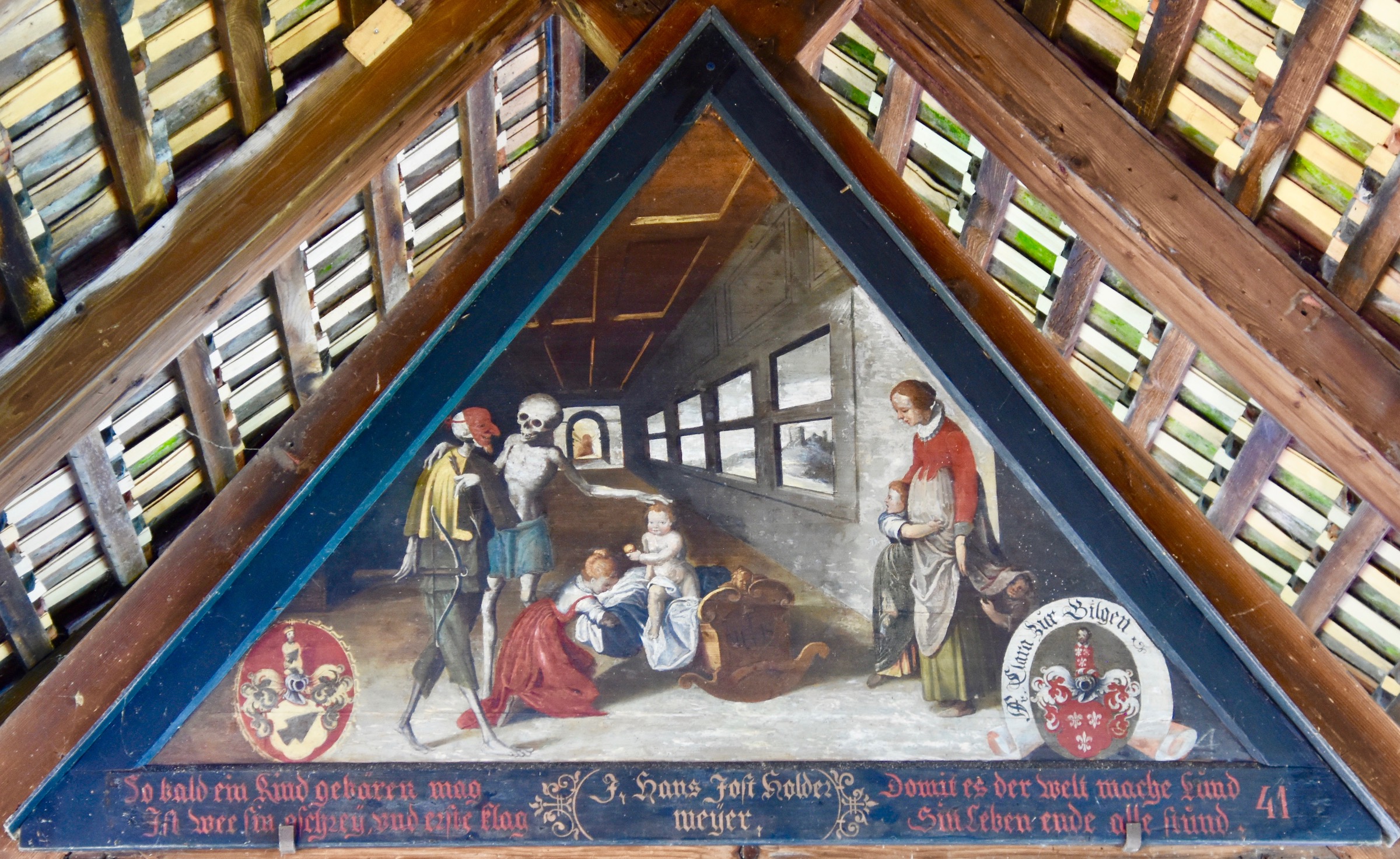
This one’s really creepy. One skeleton touches the baby’s head which causes him to hop out of the cradle, seemingly happy to join with them while the other skeleton wears a punchinello mask implying that this is all a joke. Meanwhile the other two children cling to their mother in terror.
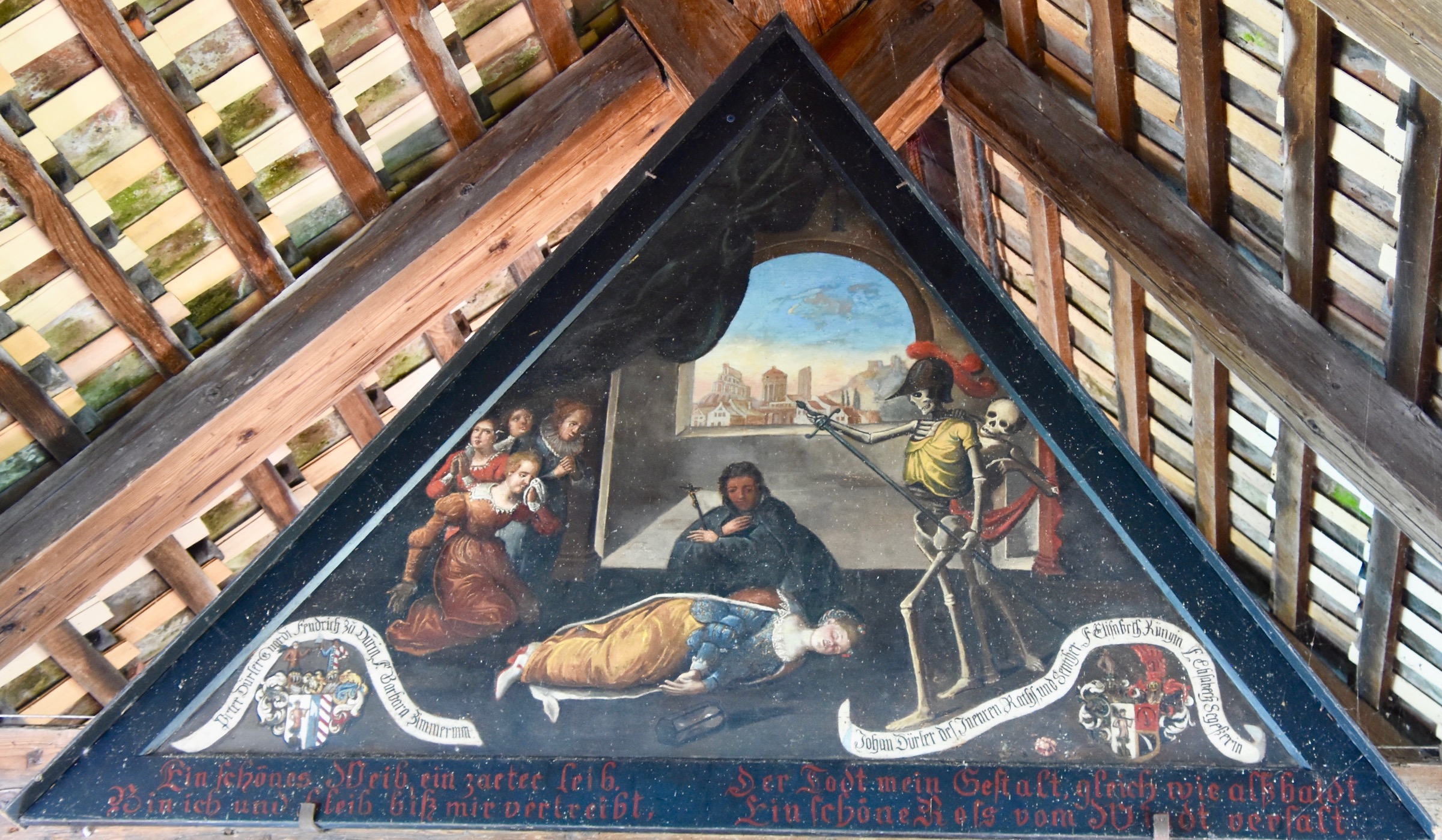
Back to killing off royals. In this scene, death as a knight is just putting his sword back in the scabbard after using it to dispatch the duchess who apparently to the horror of her retinue, just keeled over and died.
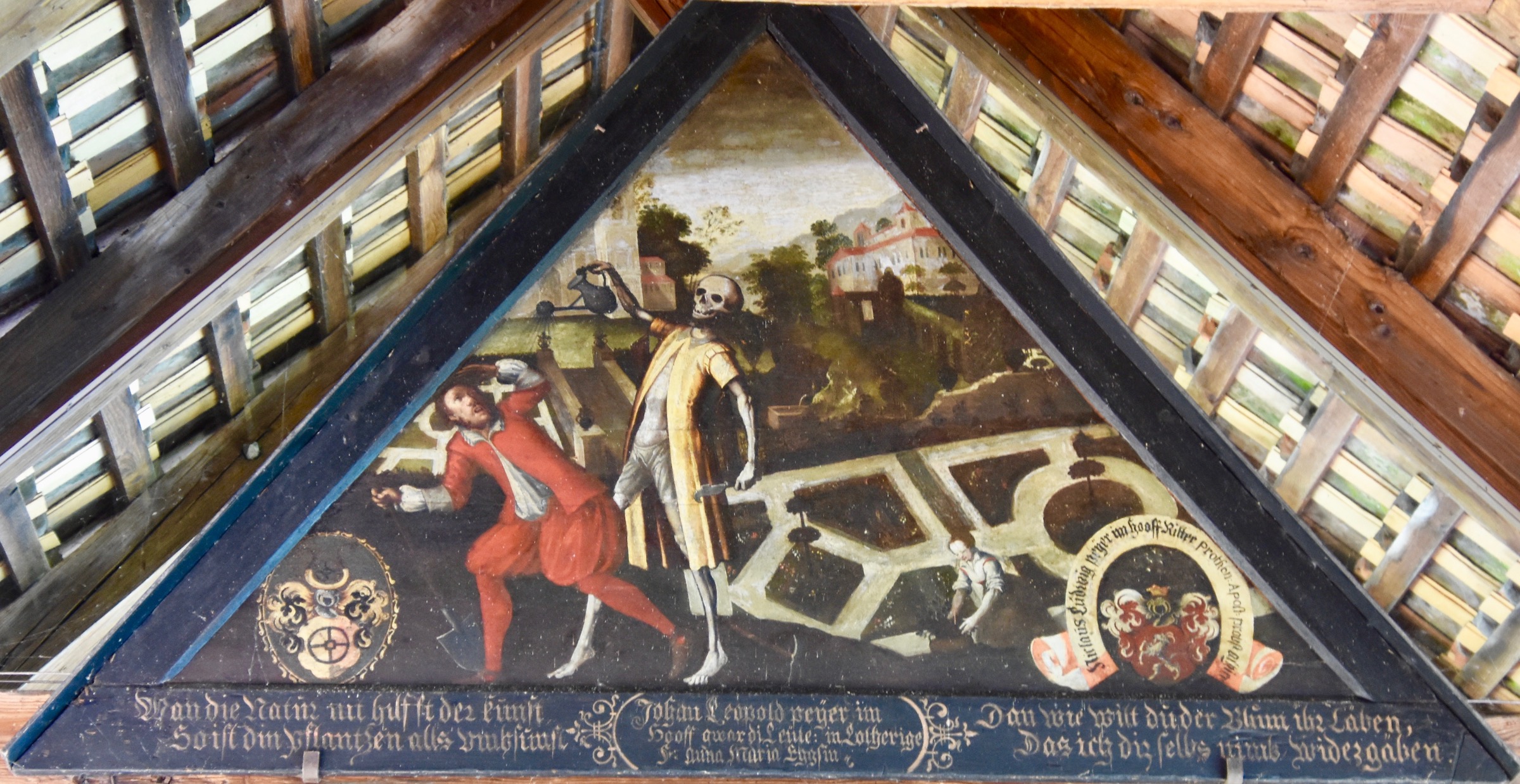
There is a whole series that portray the death of people engaged in various professions such as painters, bakers, merchants and even an astrologer. This one is the gardener who tries to avoid water being poured upon him by death, but to no avail.
I could go on and on, but if you are interested you can go this great website and see every panel, including those destroyed in the Kapellbrücke fire and those from the Court bridge which was demolished in the 19th century.
After looking at too many Totentanz paintings it’s time for some fresh air and sunshine. This is the view from the middle of the Chaff Bridge. You can see that the Lucerne weir divides the river into two parts with the main body of water passing under the bridge.
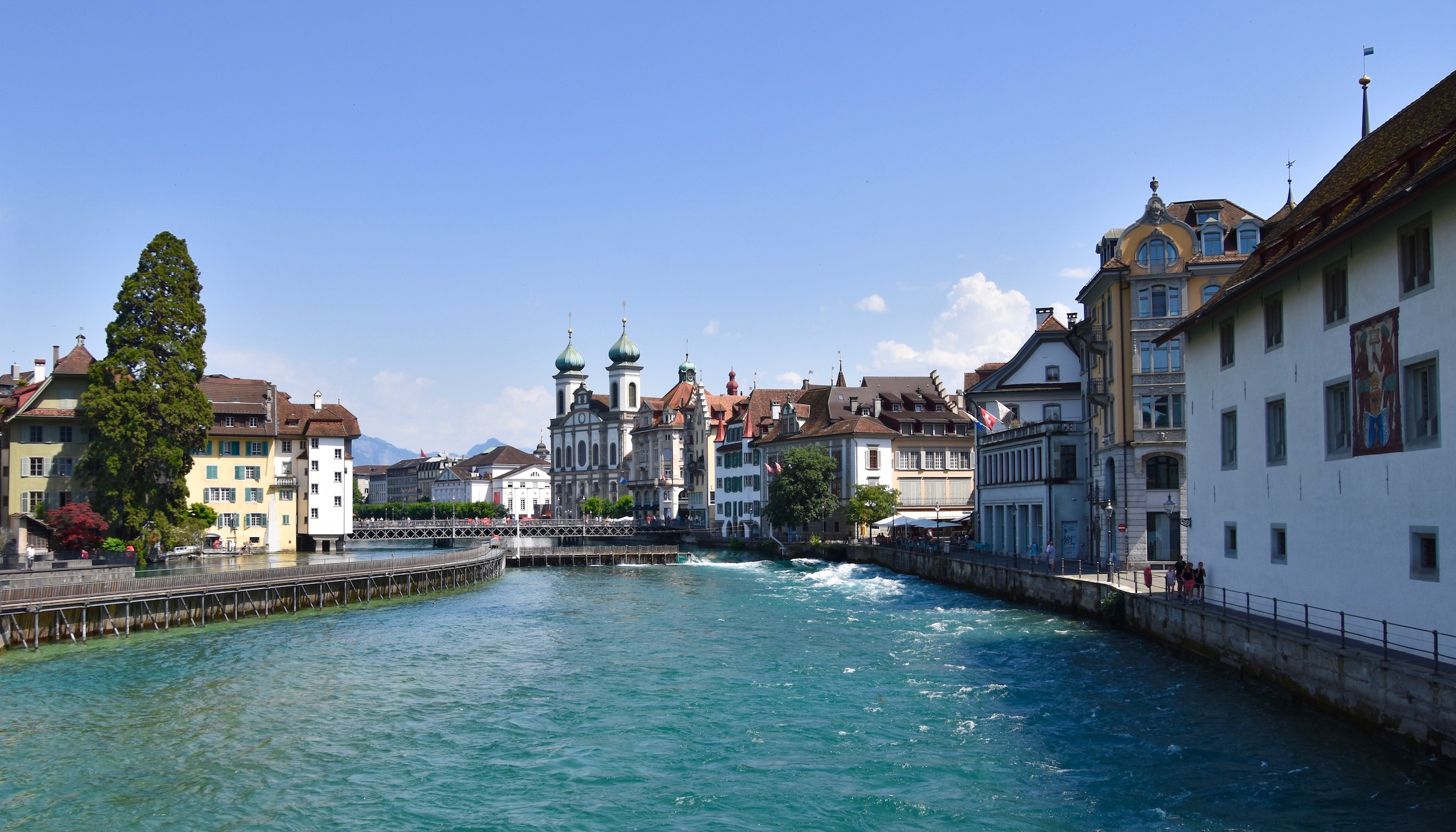
Looking down, I spotted this very handsome red-crested pochard drake strutting his stuff for any interested female onlookers. These are diving ducks and they are fun to watch as they take on the swift currents in search of the aquatic plants that make up their diet. I find that even in the most urban of settings you can always find mother nature at work if you know where to look.
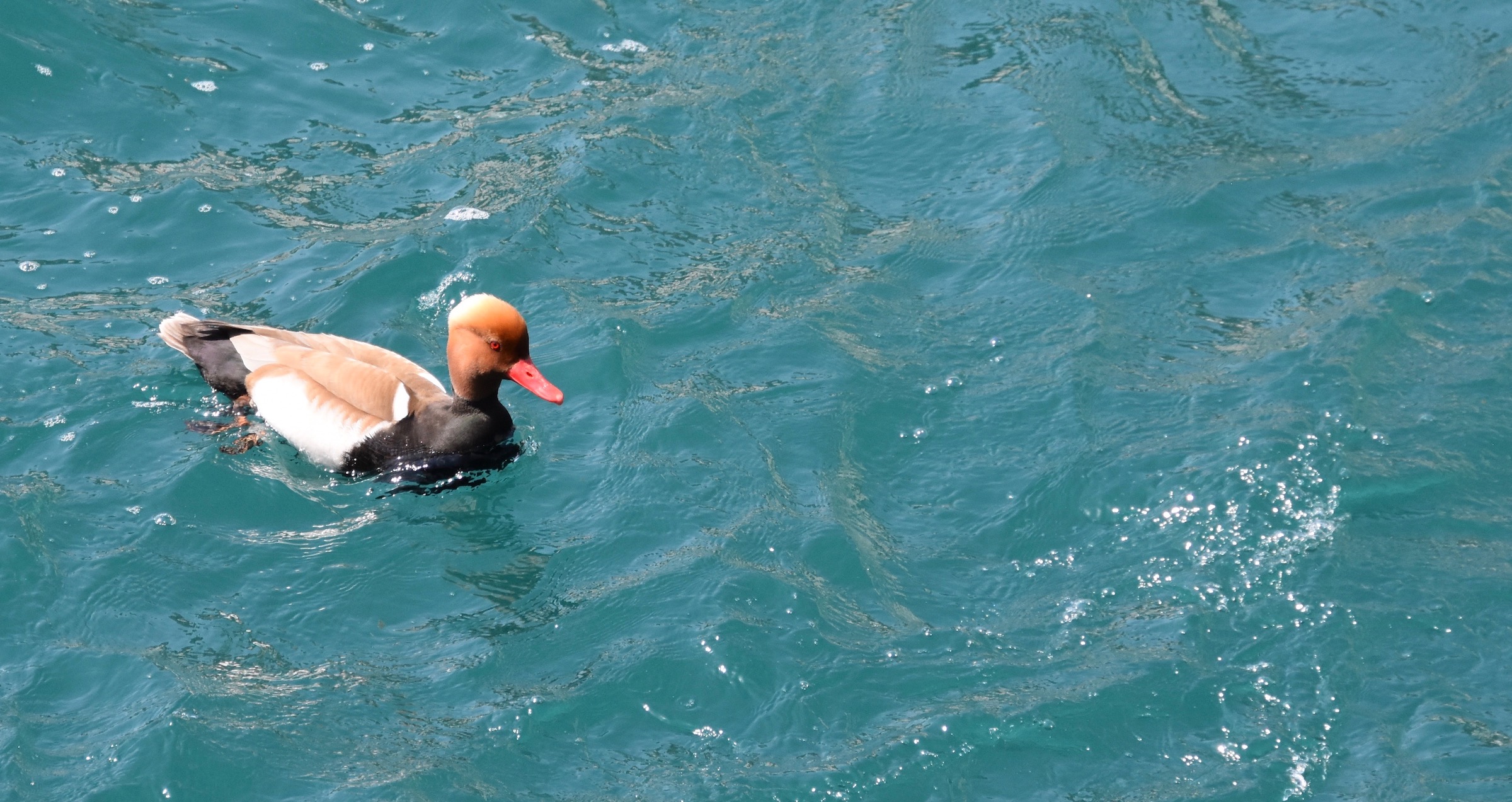
As you exit the bridge into the oldest part of Lucerne you pass over the portion of the river that has been diverted by the weir to provide propulsion for the turbines that produce enough electricity to power up to 1,500 homes in Lucerne. The original hydro power plant dates all the way back to 1859 and has since been upgraded to include the most modern and efficient hydro electric equipment. Once again the Swiss demonstrate that you don’t have to create air pollution or destroy entire landscapes to generate electricity.
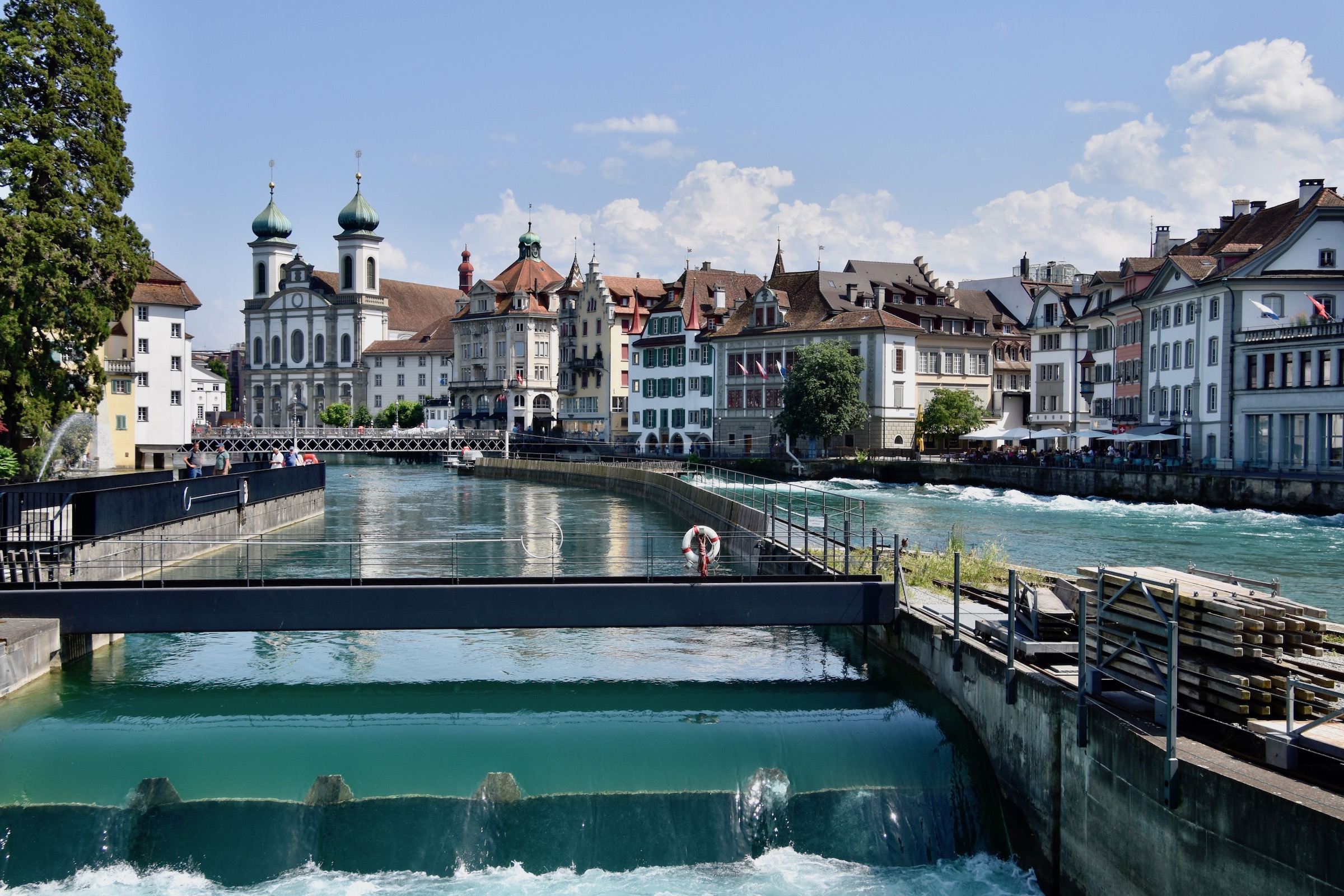
Looking back at the Chaff Bridge I couldn’t help but notice this interesting sign affixed to it. I guess the Swiss have even taught their dogs to read and obey signs like this.
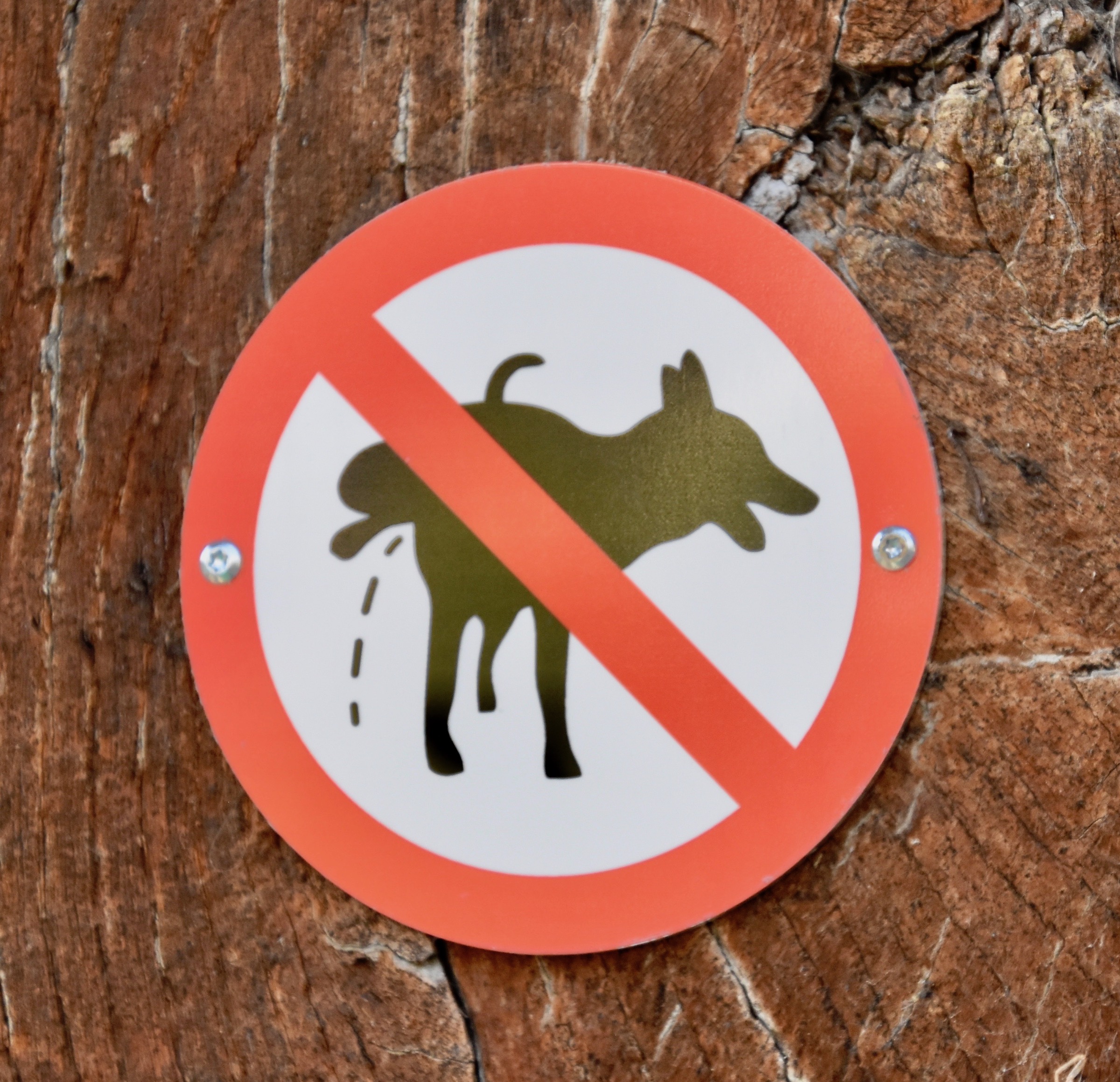
Long before the waters of the Reuss were being used to generate electricity, it was turning the waterwheels of the many mills in old Lucerne. Yvonne points out this sign indicating that this building was once the Lucerne mint, turning out coinage from 1422 until the 19th century.
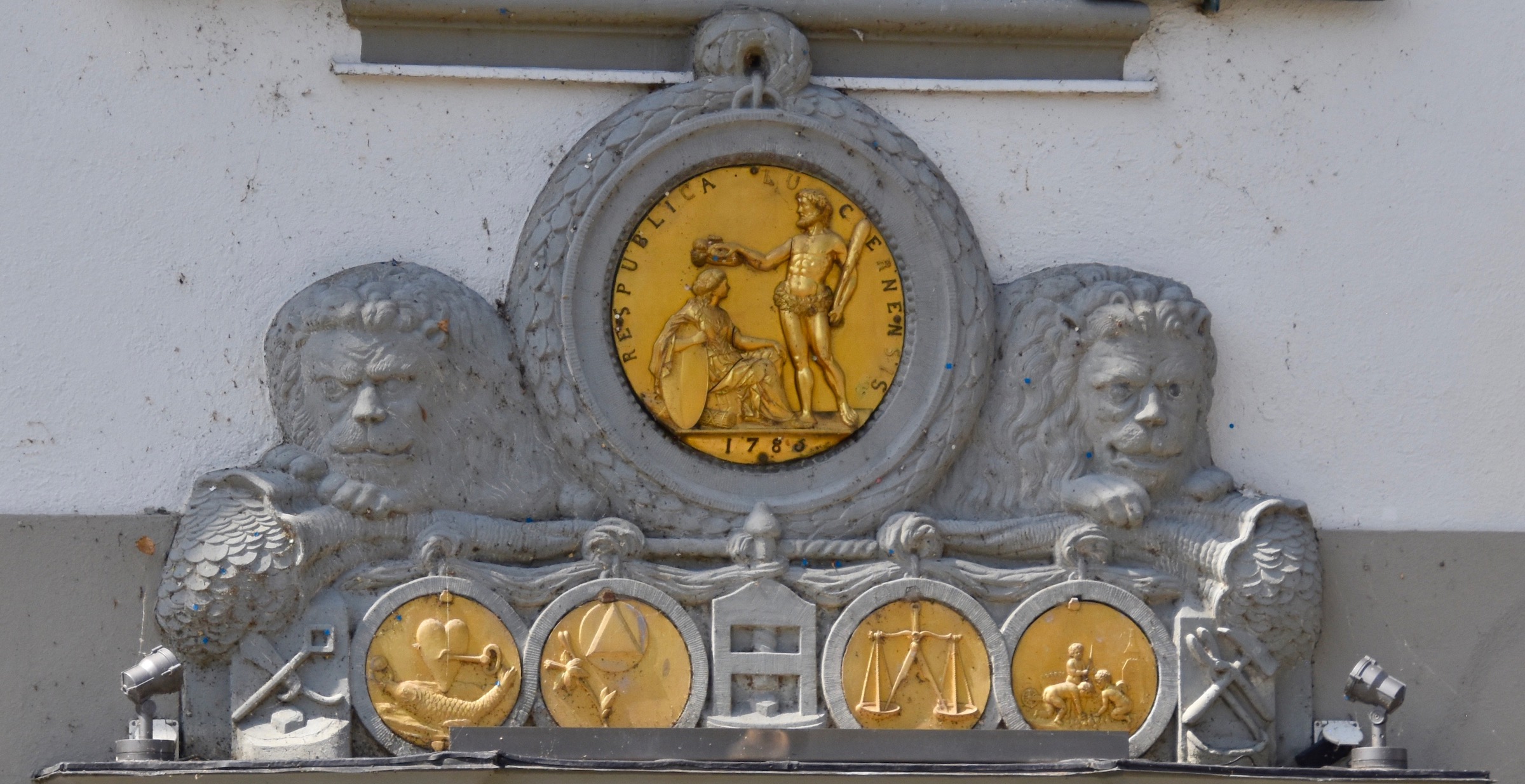
Whereas the streets on the ‘new’ side of Lucerne are quite wide and regular, those on this side are markedly narrower with no discernible pattern. We have now entered medieval Lucerne and without a guide you could easily get lost, which actually wouldn’t be so bad – this is a fascinating area. There are a number of small plazas where you can get your bearings and appreciate the architecture. Remember Yvonne asked us to note the riverside facade of the Hotel des Balances with it’s plain white and black appearance? Well this is what you see approaching the hotel entrance from dry land. I was going to suggest that the ugly duckling had become a swan, but I think it might be the other way around.
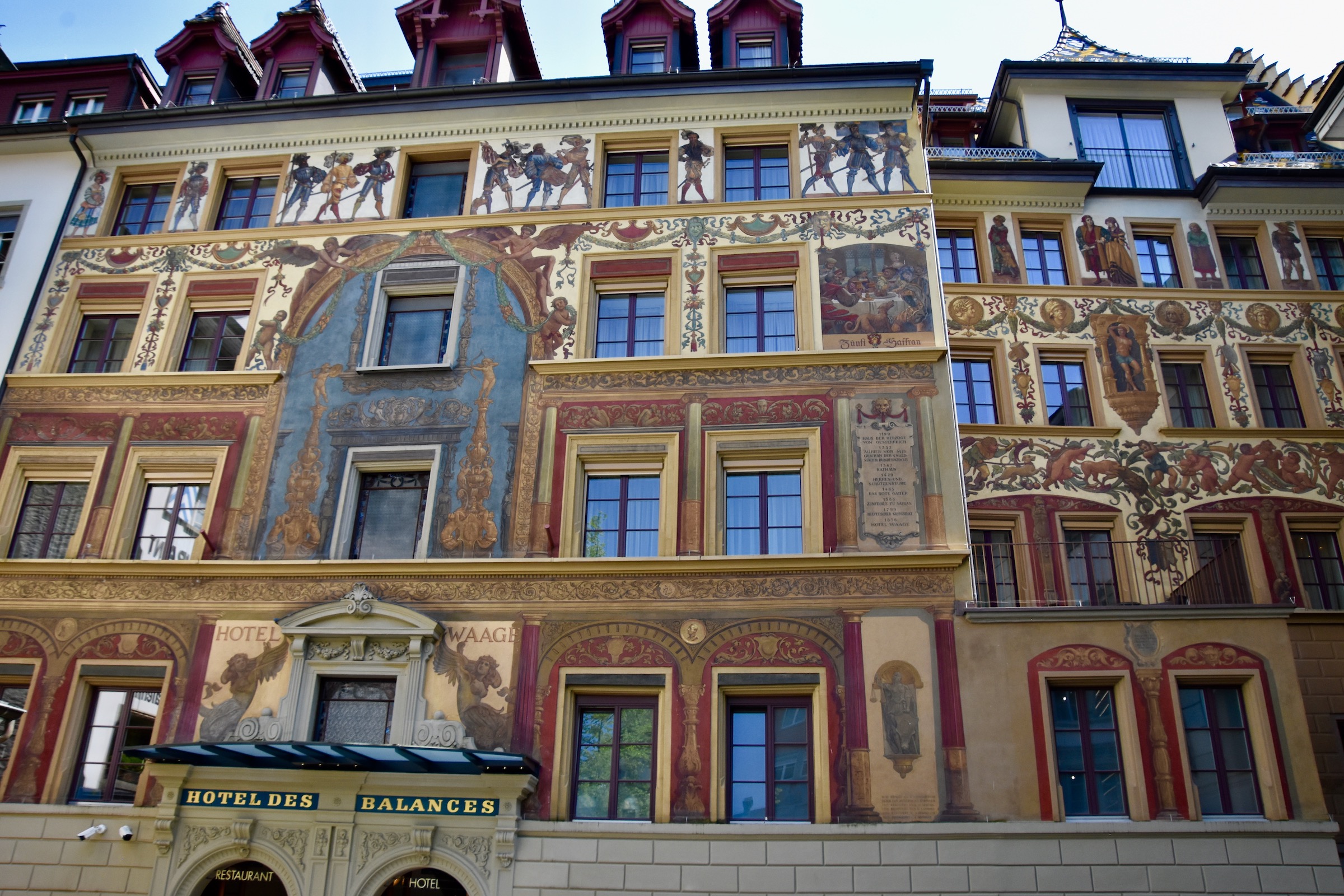
One of the real pleasures in walking around the medieval areas of Swiss cities is taking in and photographing the many very original sings that mark various businesses and hotels. Lucerne is no different and here are just a few you might look for.
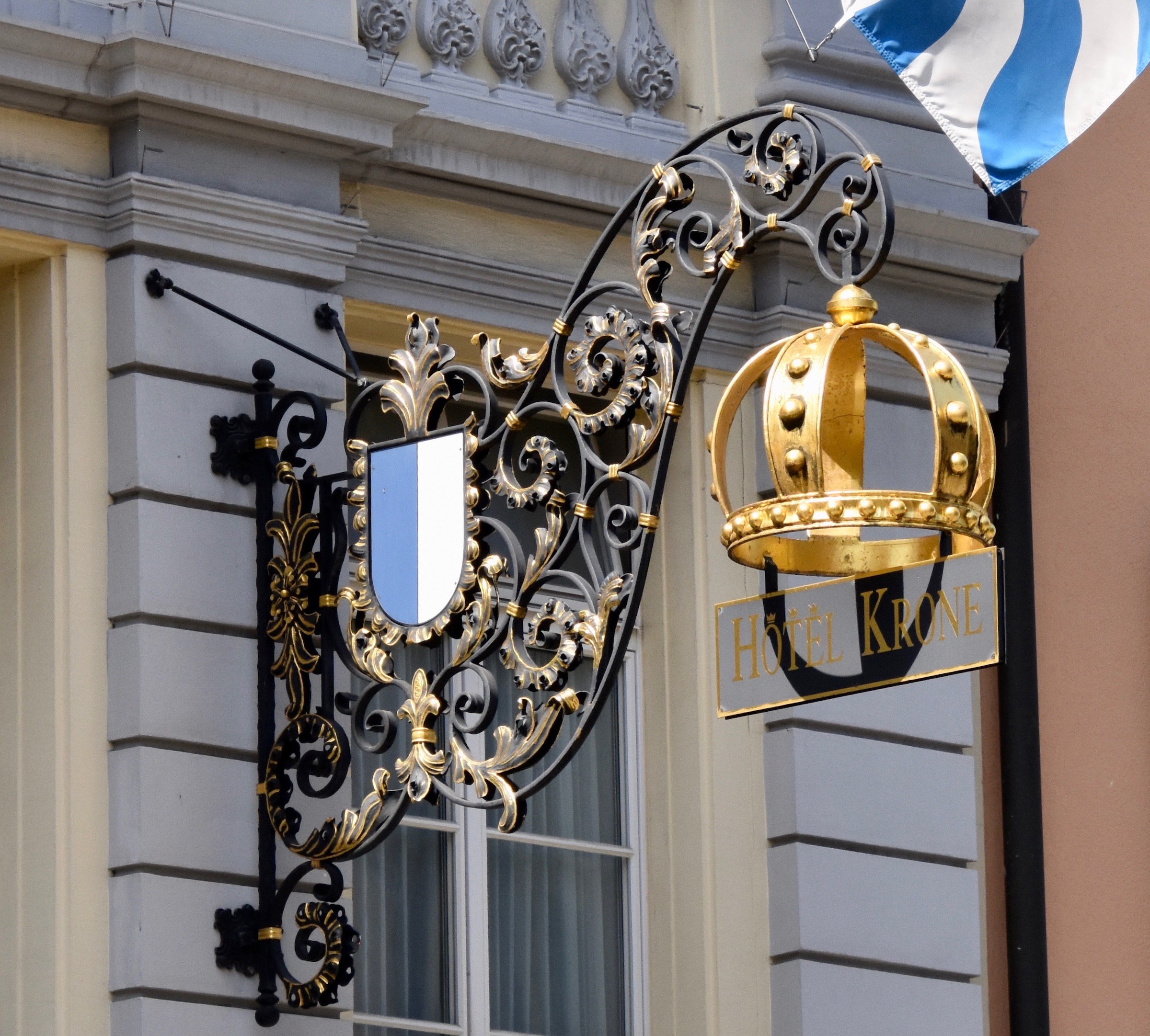
Rent a Box is actually a high end jewelry and watch store. Note the pineapple finial.
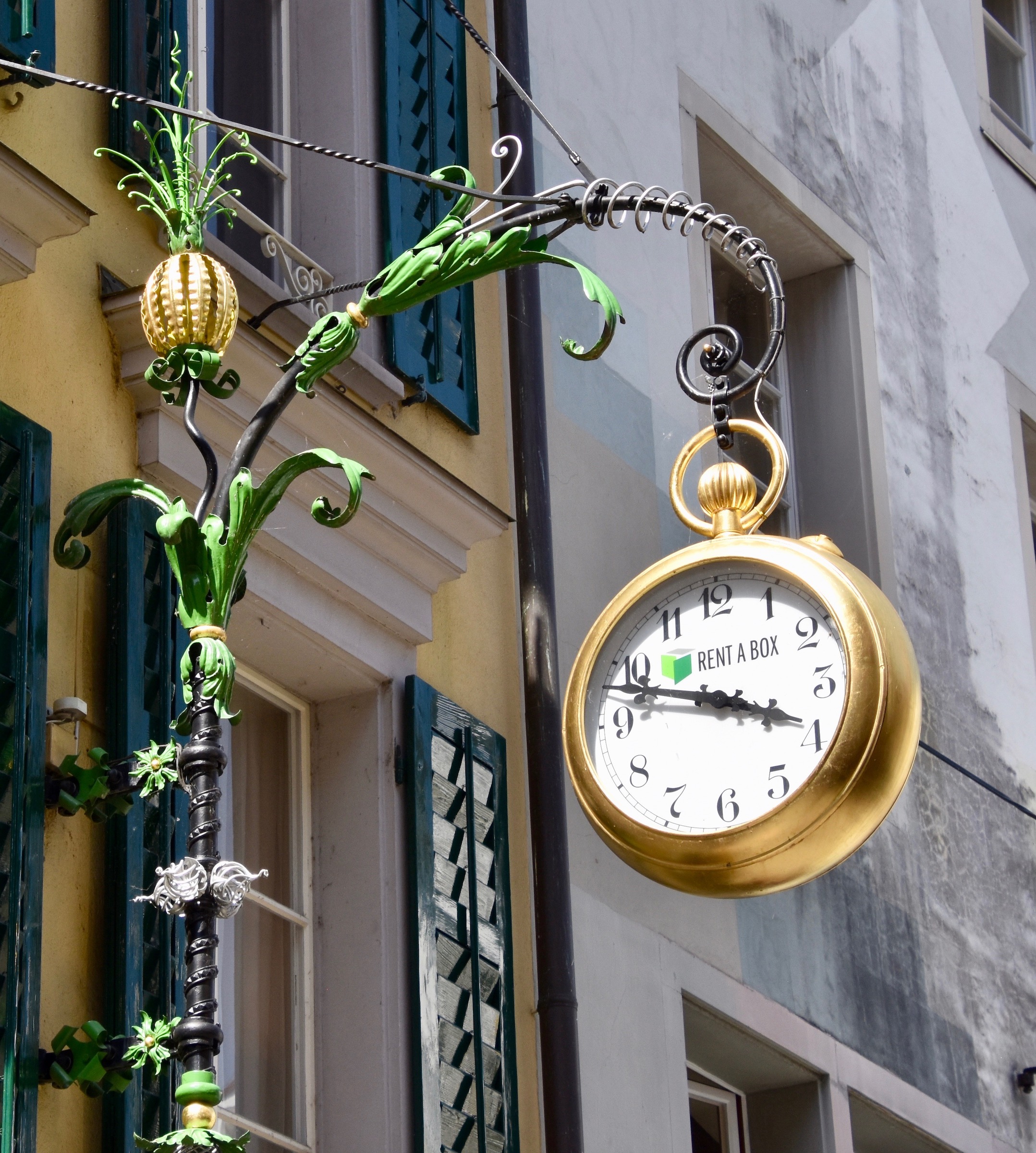
This one is particularly ornate.
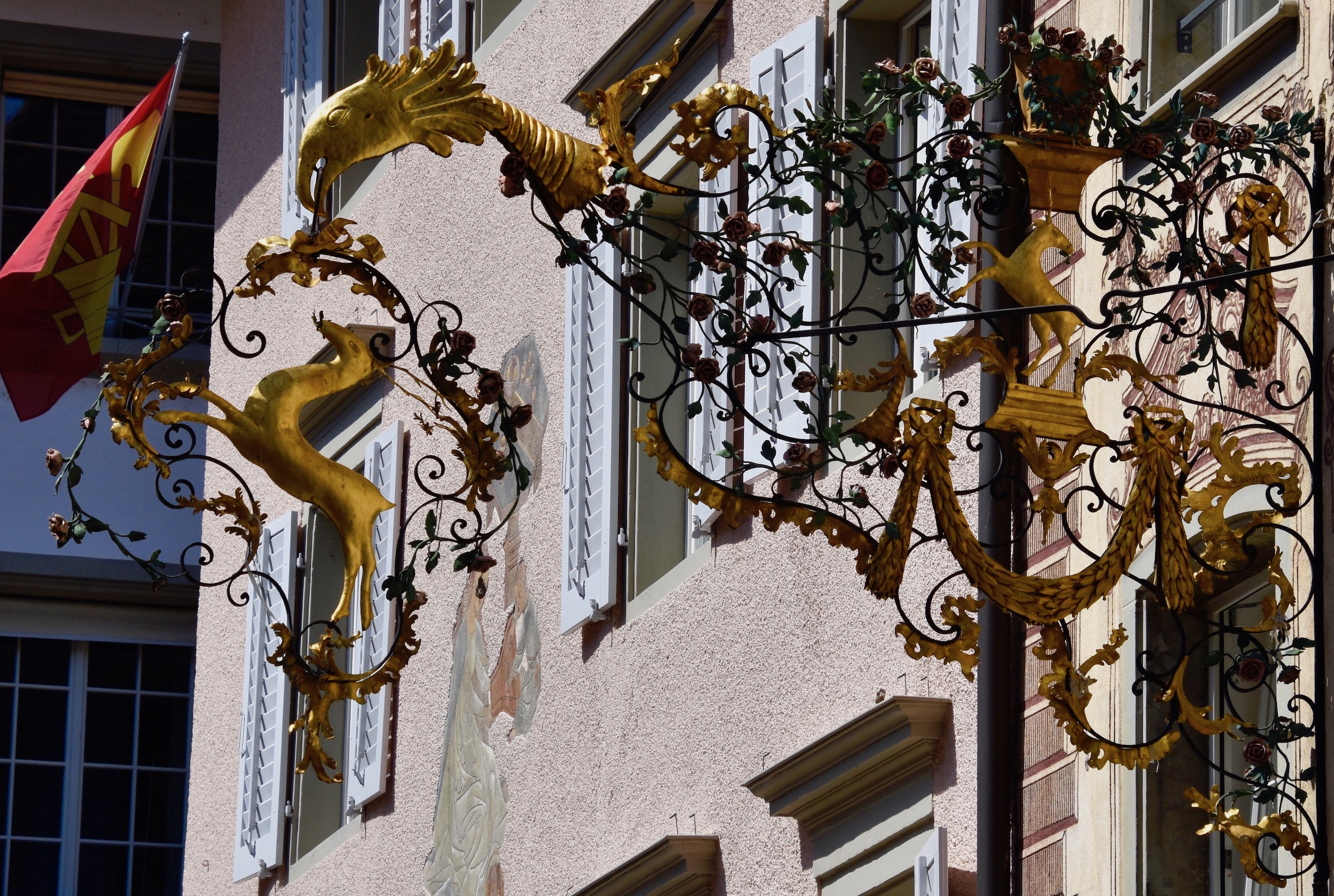
And lastly a pretzel maker.
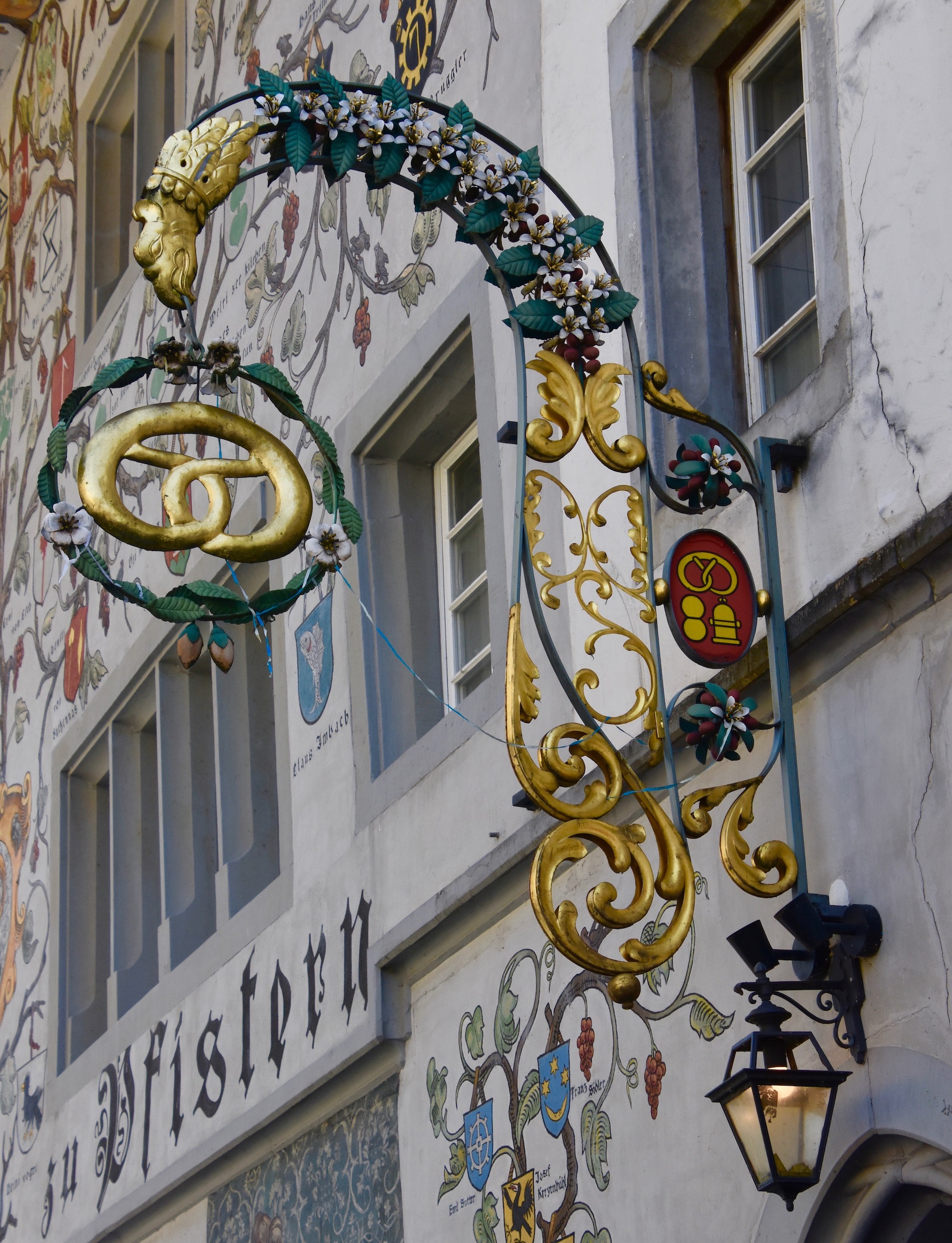
It’s not only the signs that are interesting, but the facades of the buildings as well as we saw with the Hotel des Balances. This which at first glance you might mistake for The Last Supper, is actually the much more joyous occasion of the Marriage of Cana where Jesus pulled off his first and to my mind greatest miracle, turning water into wine.
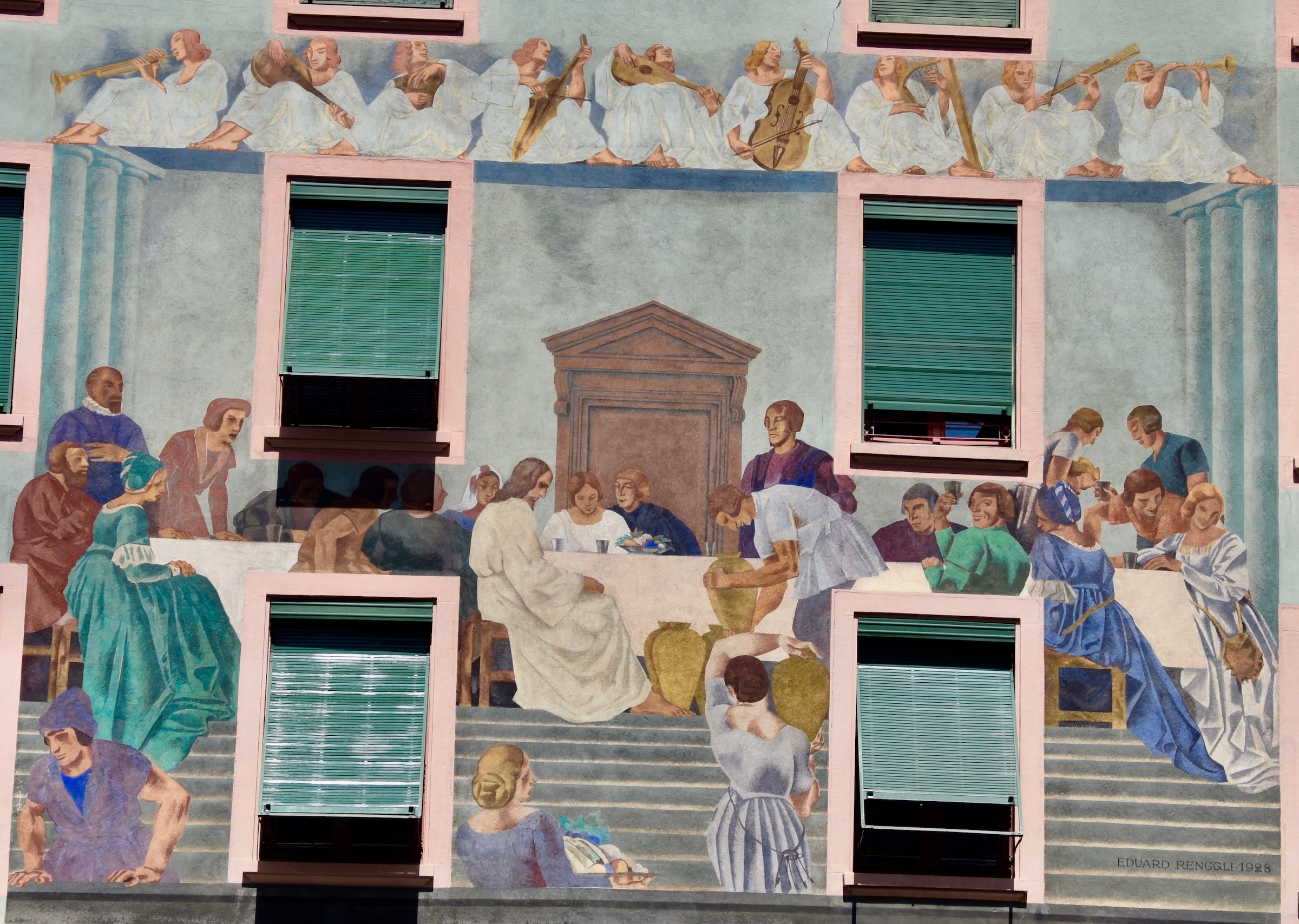
No self respecting Swiss city would be without its clocktower and Lucerne is no exception. Each has a different claim to fame and Lucerne’s is that not only does it tell the time, but it also shows the phases of the moon. Why that would be a big deal when all you have to do is look up to see which phase the moon is in, I don’t know. The clock tower is attached to the back of the Rathaus, but is much older, dating back to the late Middle Ages. Unlike public clocks in much of the rest of the world which are often seized up or wildly inaccurate, in Switzerland that would be a travesty. As you can see it is ten to four and our tour is about to wind up.
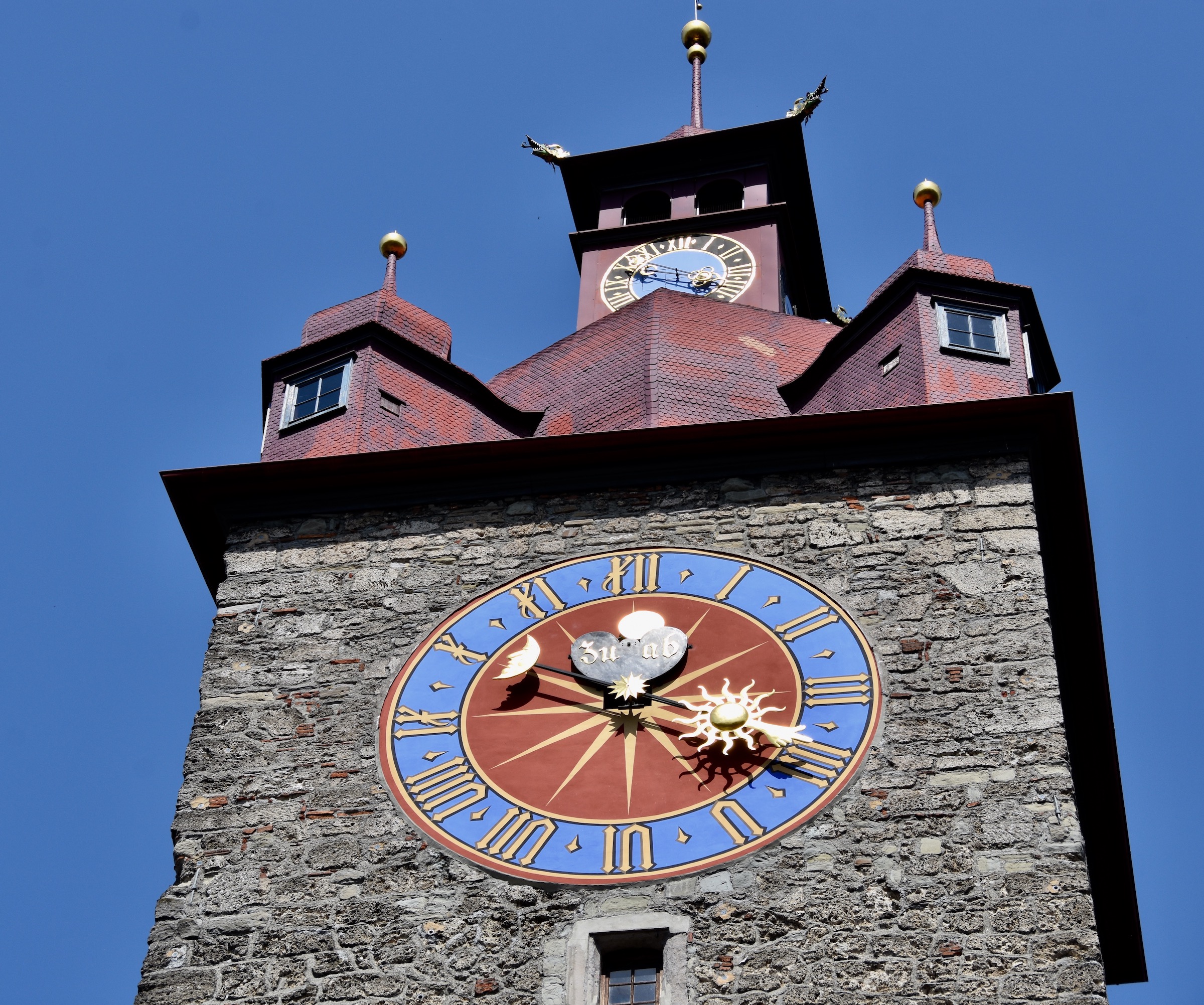
We end it in the Kappellplatz which is at the north end of the Kappellbrücke. Just as no Swiss city foregoes a clock tower neither do they stint on their gorgeous fountains. This is the Carnival Fountain which is where the celebration of Carnival begins every year. While the fountain is relatively new, it stands on a spot that has a tradition going back to the 15th century. Legend has it that a simple farmer named Fritschi is buried under it. When he died Fritschi left a bequest that provided for the poor to be given wine during carnival and not only was it honoured, but it continues to this day. On that note we’ll say goodbye to Yvonne, and Alison and I will head to a riverfront cafe to sample some of that Lucerne wine.
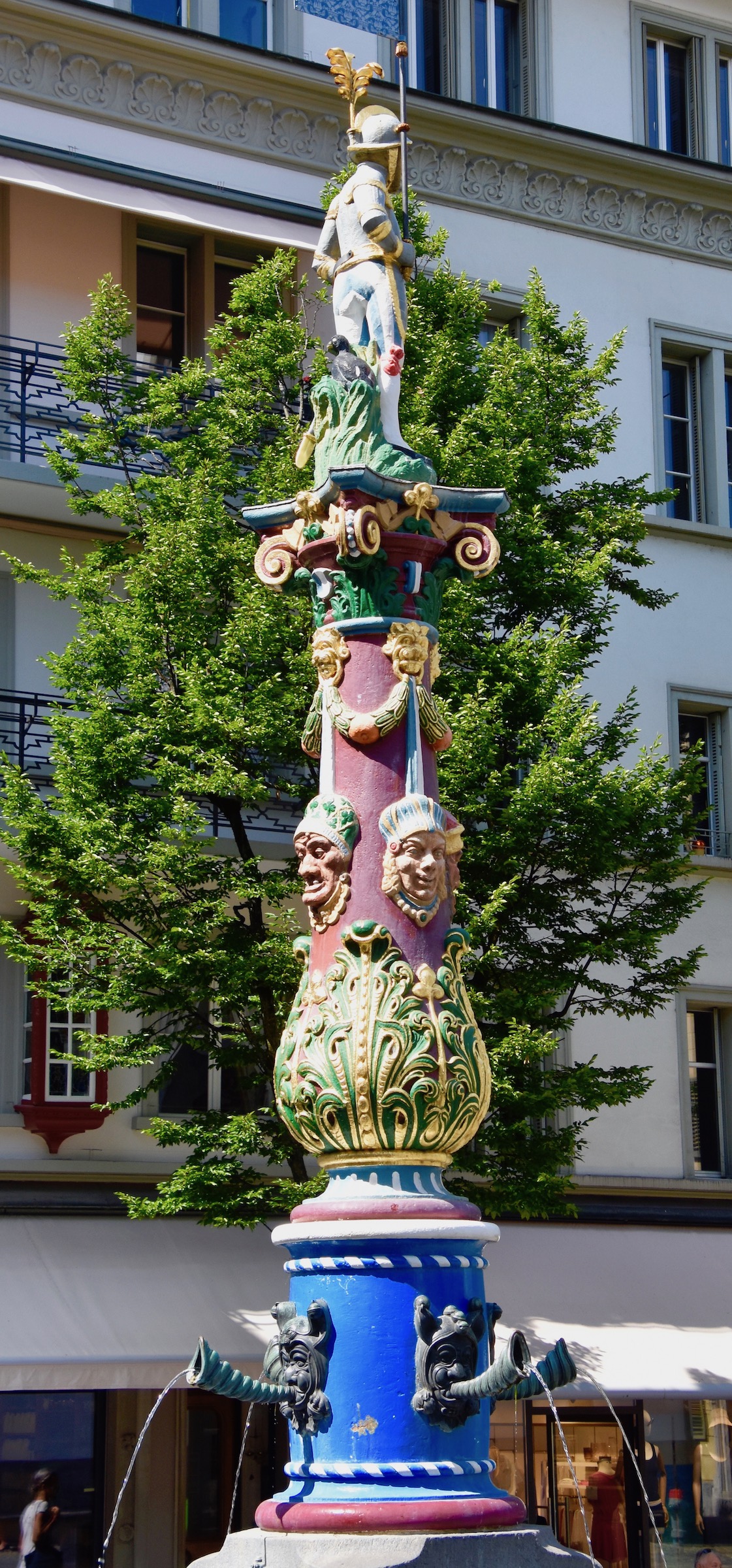
In the next post Alison and I will do some exploring on our own as there is a lot more to see in Lucerne including the city walls, the famous lion and a wonderful art gallery. I hope you’ll join us.

